RELG 402 - World's Living Religions
Hindu Deities
Images in the text are linked to larger photos - click on them to see the larger pictures.
Hover the mouse over the images to see their captions.
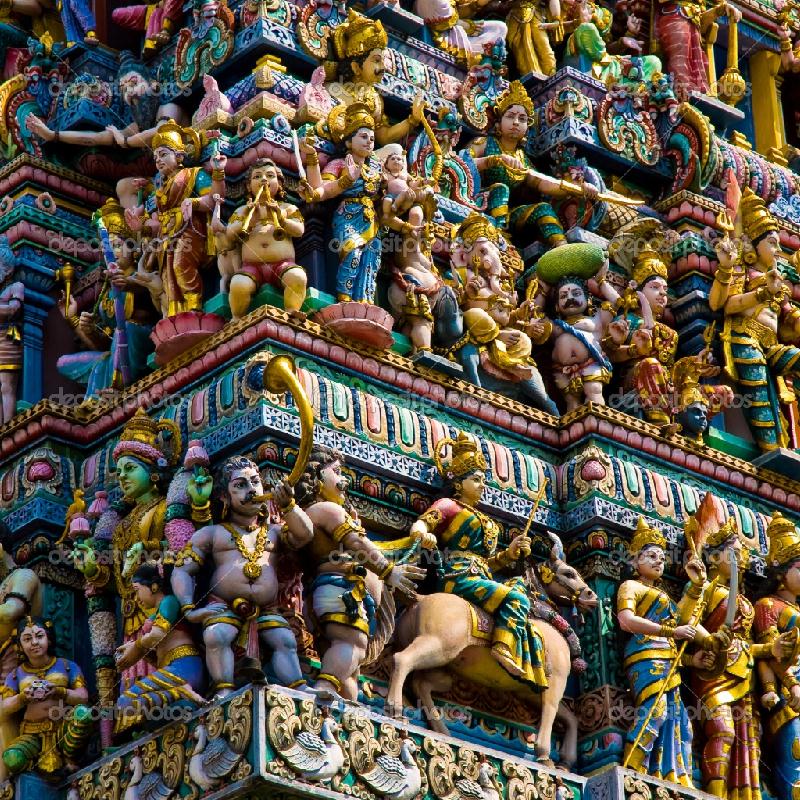 Hinduism reflects the existence of a single God manifest in hundreds of forms. Although individual Hindus may worship various gods and goddesses, the basic tenet of Hinduism is that the many gods and goddesses are all facets of one supreme God, called Brahman. Brahman has many forms and pervades the whole universe. Most Hindus believe that Brahman is present in every person as the eternal spirit or soul, called the atman.
Hinduism reflects the existence of a single God manifest in hundreds of forms. Although individual Hindus may worship various gods and goddesses, the basic tenet of Hinduism is that the many gods and goddesses are all facets of one supreme God, called Brahman. Brahman has many forms and pervades the whole universe. Most Hindus believe that Brahman is present in every person as the eternal spirit or soul, called the atman.
Brahman (note the spelling - with an "n" on the end) may be used by monistic Hindus (those who believe that all reality is ultimately one) to denote the divine reality - which they understand to be the supreme unitary reality which is the source of all being and the source of all knowing.
Dualistic Hindus (those who understand the divine reality as being separate from the rest of reality) may use the term Brahman to denote a universal being who encompasses all the various deities worshiped by Hindus.
So all the Hindu gods and goddesses may be seen as various powers or manifestations of the one "ground of all Being".
Brahman may also be understood as the true nature of all that exists, but it can only be described by general attributes - it is infinite being, infinite awareness, infinite bliss.
So Hindus may understand God to be simultaneously One (Brahman, the Ground of all Being) and many (the deities which are worshiped, and are manifestations of Brahman).
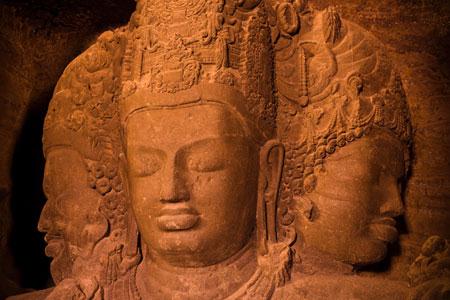
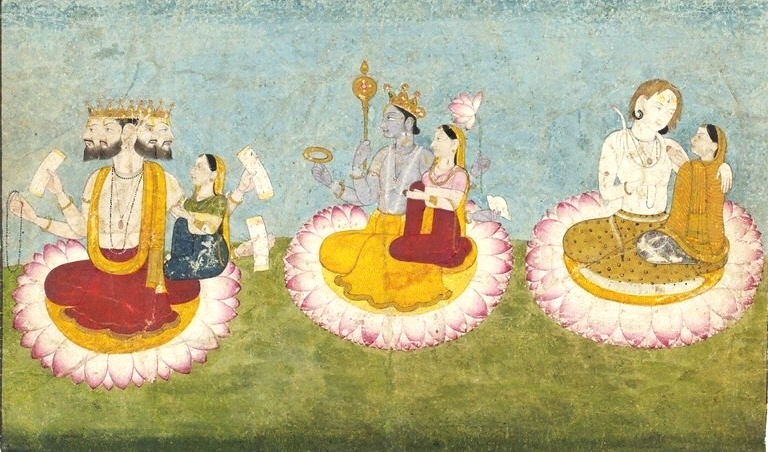 There are three main aspects of Brahman, which are expressed as a trinity, called Trimurti. They are Brahma, the creator; Vishnu, the preserver; and Shiva, the destroyer. These manifestations represent the cyclical nature of the universe.
There are three main aspects of Brahman, which are expressed as a trinity, called Trimurti. They are Brahma, the creator; Vishnu, the preserver; and Shiva, the destroyer. These manifestations represent the cyclical nature of the universe.
There are many thousands of lesser gods and goddesses in Hinduism. These are all ways of understanding aspects of the one God called Brahman.
Hindu deities are called Deva (male) or Devi (female).
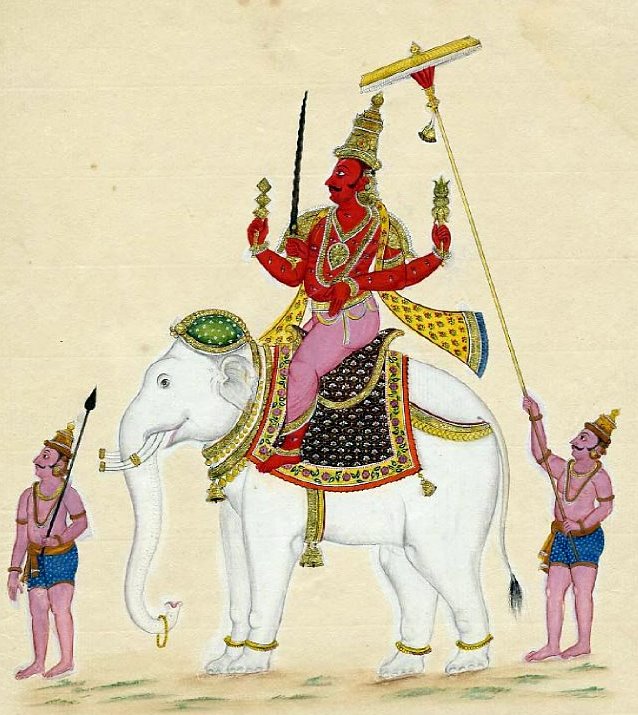
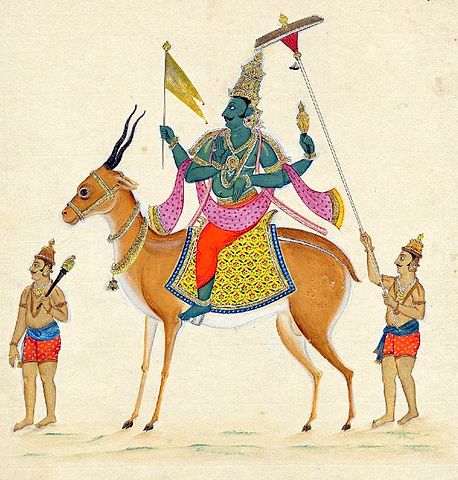
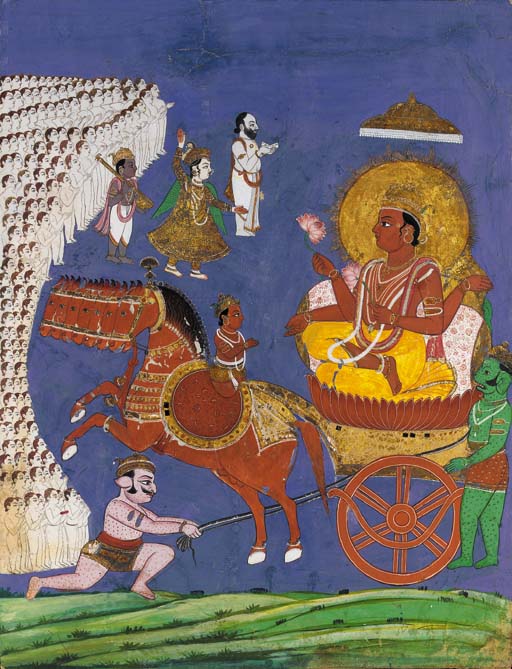 In the Vedic period they represented forces of nature (fire, wind, etc.) or moral values (courage, honesty). The three main deities in the Rig Veda were Indra, Agni (fire), and Soma. Others were Surya (sun), Vayu (wind), Ushas (dawn), Prithvi (earth), Aditi (cosmic moral order), Saraswati (river, knowledge), Vac (sound, speech), Nirrti (destruction), Ratri (night), Aranyani (forest), and goddesses Dinsana, Raka, Puramdhi, Parendi, Bharati, Mahi. The goddess Sri developed later into Lakshmi. Now-a-days Sri, or Shri, may be added to a person's name as an honorific, to denote status, position, or wealth.
In the Vedic period they represented forces of nature (fire, wind, etc.) or moral values (courage, honesty). The three main deities in the Rig Veda were Indra, Agni (fire), and Soma. Others were Surya (sun), Vayu (wind), Ushas (dawn), Prithvi (earth), Aditi (cosmic moral order), Saraswati (river, knowledge), Vac (sound, speech), Nirrti (destruction), Ratri (night), Aranyani (forest), and goddesses Dinsana, Raka, Puramdhi, Parendi, Bharati, Mahi. The goddess Sri developed later into Lakshmi. Now-a-days Sri, or Shri, may be added to a person's name as an honorific, to denote status, position, or wealth.
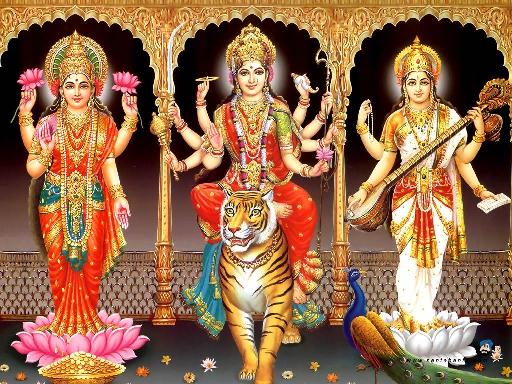 Over time an extensive literature developed, including the Puranas, with genealogies and stories of the various deities, who developed distinctive attributes and personalities.
Over time an extensive literature developed, including the Puranas, with genealogies and stories of the various deities, who developed distinctive attributes and personalities.
To balance the trinity of male gods, a trinity of goddesses emerged, the Tridevi, - Saraswati (the Creator), Lakshmi (the Preserver), and Parvati or Kali (the Destroyer).
![]()
Creation
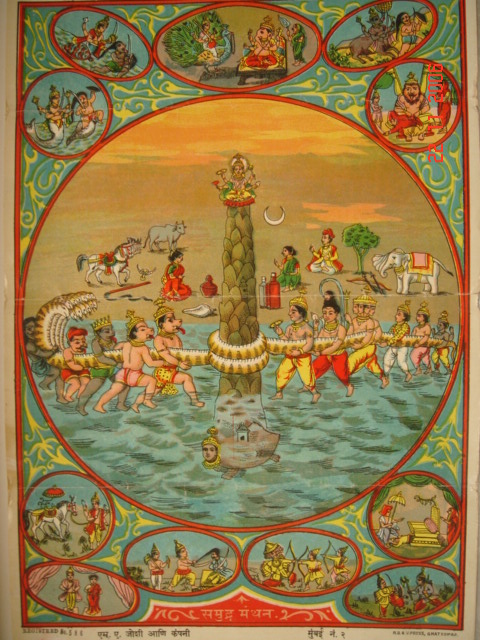 According to legends, there was a time when devas (gods) and asuras (demons) were mortal. There was a celestial nectar, called Amrit, that granted immortality, but it could only be made by churning the primordial Kshirsagar (Ocean of Milk). So the devas and the asuras formed two groups to churn the Ocean of Milk. Vishnu became incarnate as the turtle Kurma, to form the churning paddle. A tall mountain was placed on his back as a pole, and the serpent god Vasuki wrapped himself round the pole to form the rope for turning. Devas and asuras pulled on each end of the serpent, and churned the Ocean of Milk for a millennium to create the universe and to produce the Amrit. During the process many celestial articles rose to the surface, including the apsaras and the moon, a sacred white elephant, a sacred white horse, and the goddess Lakshmi emerged on a lotus flower.
According to legends, there was a time when devas (gods) and asuras (demons) were mortal. There was a celestial nectar, called Amrit, that granted immortality, but it could only be made by churning the primordial Kshirsagar (Ocean of Milk). So the devas and the asuras formed two groups to churn the Ocean of Milk. Vishnu became incarnate as the turtle Kurma, to form the churning paddle. A tall mountain was placed on his back as a pole, and the serpent god Vasuki wrapped himself round the pole to form the rope for turning. Devas and asuras pulled on each end of the serpent, and churned the Ocean of Milk for a millennium to create the universe and to produce the Amrit. During the process many celestial articles rose to the surface, including the apsaras and the moon, a sacred white elephant, a sacred white horse, and the goddess Lakshmi emerged on a lotus flower.
Also during the churning, the serpent belched out a black cloud of terrible poison, which started to kill both gods and demons. Only Shiva was able to help, which he did by drinking the poison. His consort Parvati grabbed his throat to stop the poison spreading, and as a result his throat turned blue.
![]()
Agni
 Agni is the Vedic Fire God, and also the god of knowledge. He is the personification of the sacrificial fire, the divine model for the sacrificial priests, and the bearer of the sacrifices to the other gods. He is identified with the sacred spark hidden in all beings.
Agni is the Vedic Fire God, and also the god of knowledge. He is the personification of the sacrificial fire, the divine model for the sacrificial priests, and the bearer of the sacrifices to the other gods. He is identified with the sacred spark hidden in all beings.
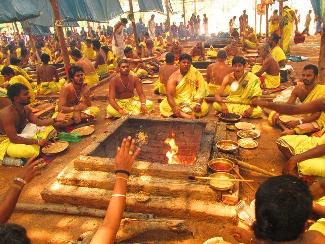 The sacrificial fire is known as yajna. Agni is invoked before any fire offering; if the offering is of flesh (animals, etc) the fire is obtained from the sun's rays.
The sacrificial fire is known as yajna. Agni is invoked before any fire offering; if the offering is of flesh (animals, etc) the fire is obtained from the sun's rays.
Agni is also the fire which consumes the corpse in a ritual Hindu funeral, so he is much feared.
 Agni is depicted as red skinned, with black eyes and hair, two heads, three legs and several arms. He rides on a ram or in a chariot drawn by horses of fire, goats, or parrots. Seven rays of light shine form his body, and he has seven fiery tongues which lick up the butter poured in a sacrifice. Sometimes he is encircled by a ring of flames around his body.
Agni is depicted as red skinned, with black eyes and hair, two heads, three legs and several arms. He rides on a ram or in a chariot drawn by horses of fire, goats, or parrots. Seven rays of light shine form his body, and he has seven fiery tongues which lick up the butter poured in a sacrifice. Sometimes he is encircled by a ring of flames around his body.
Agni is present in the sacrificial fire which is used at the main life-stages for a Hindu - the lamp at birth, the lamp at prayers. the fire which a bride and groom circle during a Hindu wedding, and the fire of the funeral pyre.
![]()
Brahma
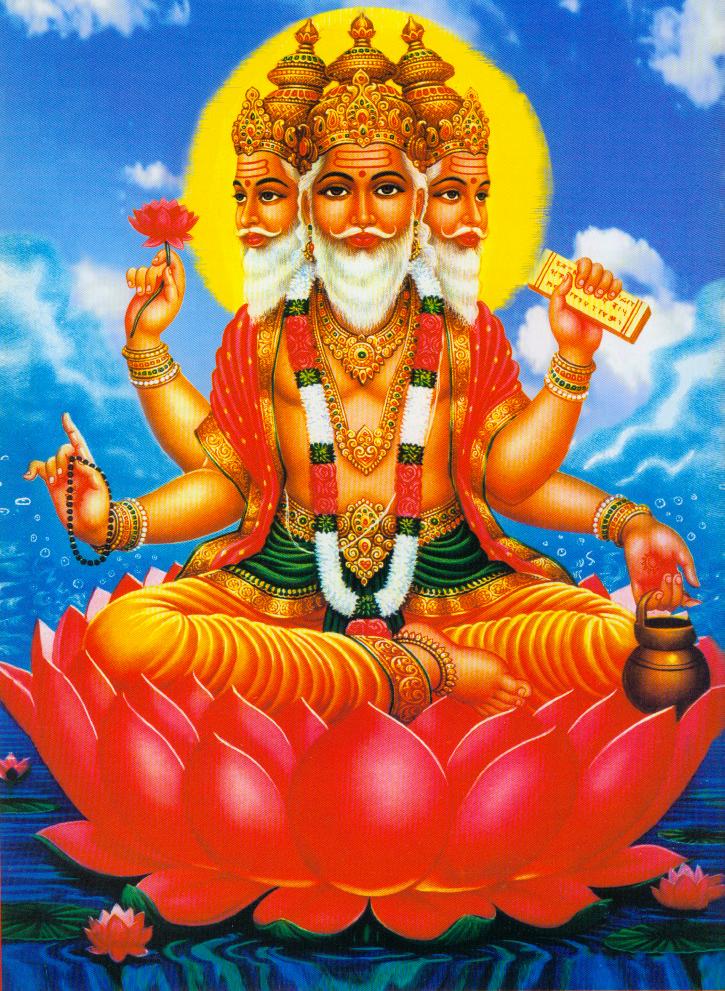 Brahma is the creator god. He has four faces, looking in the four directions (some pictures show only three). He is also regarded as the lord of speech, who created the four Vedas - one from each of his mouths.
Brahma is the creator god. He has four faces, looking in the four directions (some pictures show only three). He is also regarded as the lord of speech, who created the four Vedas - one from each of his mouths.
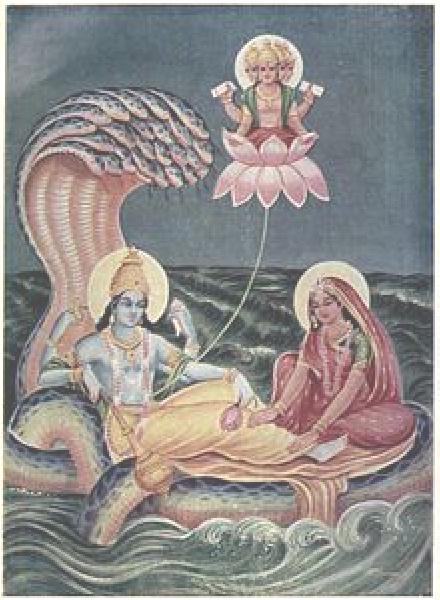 Although he is regarded as a creator of the universe, some of the Puranas, and some of the pictorial representations, show him as issuing from the navel of Vishnu. Other puranas say that he was born from one of the aspects of Shiva. Although Brahma is of religious importance, he seems to be rather distant from most Hindus - not many temples are dedicated to Brahma. Brahma is usually portrayed with four faces and four arms. He wears crowns or diadems, and in his hands he holds no weapons, but only symbols of creation and knowledge - the sacred texts of the Vedas, Prayer Beads, a ladle to feed the sacred fire, and a container of water symbolizing the source of creation. His hand positions indicate gift-giving and granting refuge. He may be seated on a lotus, or on hansa (his goose or swan). His consort is usually regarded as Saraswati, although Savitri is also associated with him.
Although he is regarded as a creator of the universe, some of the Puranas, and some of the pictorial representations, show him as issuing from the navel of Vishnu. Other puranas say that he was born from one of the aspects of Shiva. Although Brahma is of religious importance, he seems to be rather distant from most Hindus - not many temples are dedicated to Brahma. Brahma is usually portrayed with four faces and four arms. He wears crowns or diadems, and in his hands he holds no weapons, but only symbols of creation and knowledge - the sacred texts of the Vedas, Prayer Beads, a ladle to feed the sacred fire, and a container of water symbolizing the source of creation. His hand positions indicate gift-giving and granting refuge. He may be seated on a lotus, or on hansa (his goose or swan). His consort is usually regarded as Saraswati, although Savitri is also associated with him.
![]()
Ganesha
 Ganesha, the elephant headed deity, is the son of Shiva and Parvati, and the brother of Lakshmi, Saraswati, and Kartikeva (who is also called Skanda and Murugan - the god of war). Ganesha is the god of wisdom, good fortune and prosperity, and also the god of beginnings - so he is invoked at the start of ceremonies and rituals. His animal is the mouse, and his weapon the ankusa.
Ganesha, the elephant headed deity, is the son of Shiva and Parvati, and the brother of Lakshmi, Saraswati, and Kartikeva (who is also called Skanda and Murugan - the god of war). Ganesha is the god of wisdom, good fortune and prosperity, and also the god of beginnings - so he is invoked at the start of ceremonies and rituals. His animal is the mouse, and his weapon the ankusa.
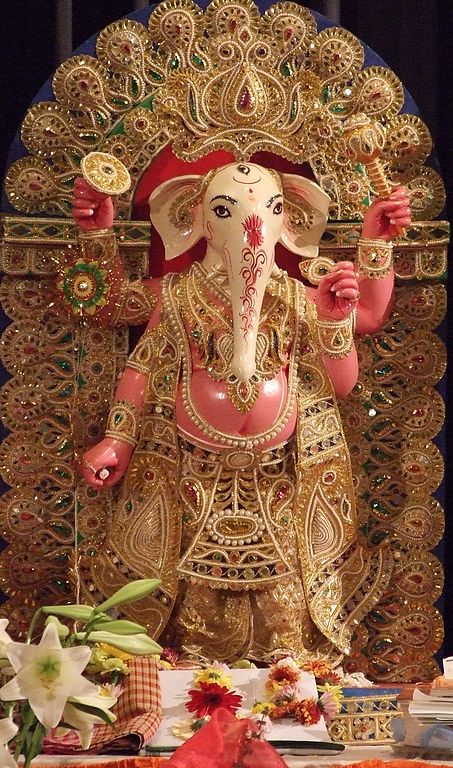 The Mahabharata epic says that the sage Vyasa asked Ganesha to write the poem down as Vyasa recited it. It is believed that Ganesha used one of his own tusks to write with - hence his statues show him with a broken tusk.
The Mahabharata epic says that the sage Vyasa asked Ganesha to write the poem down as Vyasa recited it. It is believed that Ganesha used one of his own tusks to write with - hence his statues show him with a broken tusk.
Representations of Ganesha show him with a large head, to indicate his great wisdom, and a large belly which contains the cosmic eggs of all universes. At least one of his tusks is broken, to indicate the sacrifice necessary for learning and the pursuit of wisdom. His ears are large, to indicate listening and attentiveness to all his worshippers. His trunk indicates the ability to discern between good and evil. One of his hands is usually raised in blessing and protection. In his other hands he may hold an ox-goad (to prod humanity towards enlightenment), an axe or a sword (to cut the bonds of attachment), a dagger or chhuri (whose sharp edge indicates the narrow path to higher spirituality), a mace or gada (for the discipline needed to complete the spiritual quest), a lightning bolt (the power of spirit over mind, and mind over matter), a chakra or discus (a powerful weapon of the mind), a noose (to pull his worshippers closer to spirituality), a conch shell (the trumpet used as a call to prayer), a trident (representing Love, Wisdom, and Action), a modaka ball (sweet rice dessert) to represent the rewards of liberation), a snake (the rising kundalini within everyone), and a lotus blossom (symbolizing the ascent of the spirit from the mire of the world to the greater heights of wisdom), a pot of sacred water (to refresh his followers), a hammer (for builders), a veena or Indian lute (for the Arts), a rod or stick (for authority).
He may be shown holding a part of his broken tusk, which he used to record the scriptures as they were dictated by Vyasa.
He is often accompanied by a mouse (signifying the ability to reach into every cranny of the mind).
He is vegetarian. His offerings include fruit - pineapple for giving and sharing, mango for the fullness of the spirit, coconut for the ego (hard and tough outside, but sweet and soft inside.
![]()
Hanuman
 Hanuman, also called Mahavira, is the monkey god. The epic poems of the Ramayana and the Mahabharata describes Hanuman and his friendship with Rama. He is a master of speech, grammar, and scholarship, and knows all the Vedas. It took him only 60 hours to learn all the scriptures, which he did by accompanying Surya, the Sun God, on his daily course through the heavens. He is sometimes regarded as an avatar of Shiva, born from the same drink that caused the births of Rama and his brothers. Some traditions say that Hanuman's mother was an Apsara and his father was Vayu (the ancient Wind God); others say that he was a son granted to a king who prayed to Shiva.
Hanuman, also called Mahavira, is the monkey god. The epic poems of the Ramayana and the Mahabharata describes Hanuman and his friendship with Rama. He is a master of speech, grammar, and scholarship, and knows all the Vedas. It took him only 60 hours to learn all the scriptures, which he did by accompanying Surya, the Sun God, on his daily course through the heavens. He is sometimes regarded as an avatar of Shiva, born from the same drink that caused the births of Rama and his brothers. Some traditions say that Hanuman's mother was an Apsara and his father was Vayu (the ancient Wind God); others say that he was a son granted to a king who prayed to Shiva.
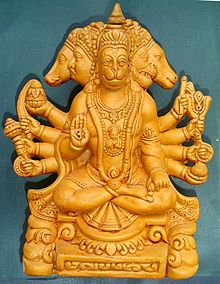 Hanuman does not have a consort - he is celibate, and celibacy is sometimes regarded as the source of his strength.
Hanuman does not have a consort - he is celibate, and celibacy is sometimes regarded as the source of his strength.
Hanuman is usually depicted with a monkey face, though there is also a five-faced form depicting the five forms he assumed in order to rescue Rama and Lakshmana and to kill Ahiravana, a demon who was holding them captive and could only be killed if five lamps were extinguished simultaneously. He may also be depicted pointing to his heart, where Rama and Sita sit enthroned as a symbol of his devotion to Rama.
Hanuman may carry a variety of weapons - parashu (Shiva's battle ax), khanda, chakra (whirling disc), dhaalam, gada, trishula, kumbha, katar, or a plate filled with blood.
![]()
Indra
 Indra is the Vedic god of fertility, rain, thunder, and war. He is the leader of the gods, and was very important in early Hinduism. He rides a white horse or a white elephant (sometimes the elephant has three or more heads), and carries a thunderbolt. He releases the dawn, and is associated with clouds and the rainbow, which is regarded a Indra's Bow.
Indra is the Vedic god of fertility, rain, thunder, and war. He is the leader of the gods, and was very important in early Hinduism. He rides a white horse or a white elephant (sometimes the elephant has three or more heads), and carries a thunderbolt. He releases the dawn, and is associated with clouds and the rainbow, which is regarded a Indra's Bow.
He is described as being golden- or brown-skinned, and may carry a bow or lances in addition to his thunderbolt. He rules a court in the heavens, where apsaras dance for him and his guests; when warriors die they join the court of Indra and live in luxury.
As Hinduism developed, and the concept of the Trimurti became dominant, Indra became less important.
![]()
Krishna
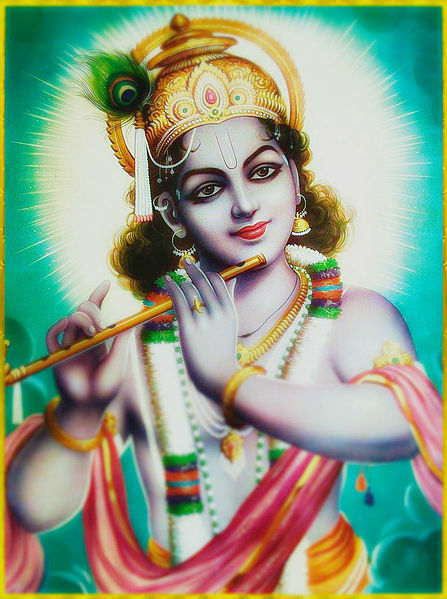 Krishna is the eighth avatar of Vishnu. He is an accomplished flute-player, and is the protector of cattle. His skin is blue or black - this is because when he was a baby a female evil demon tried to poison him.
Krishna is the eighth avatar of Vishnu. He is an accomplished flute-player, and is the protector of cattle. His skin is blue or black - this is because when he was a baby a female evil demon tried to poison him.
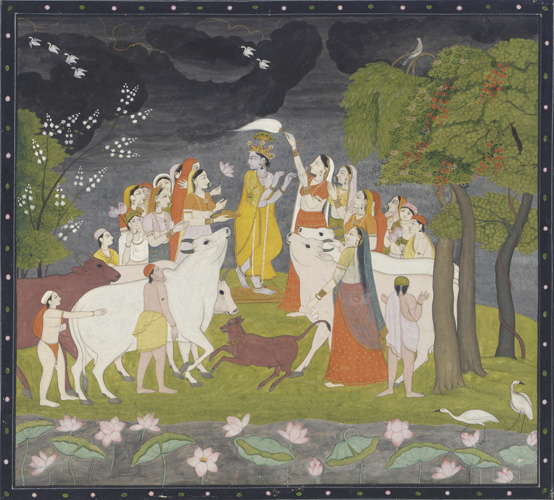 On earth he was associated with gopis - cow-girls (not the western American kind, but Indian milk-maids) whom he charmed with his flute-playing. As a 3-year-old child he loved butter, and would steal it from the gopis. As a 6-year-old he was endowed with great strength - he was able to lift a whole mountain with one hand.
He is depicted playing the flute, or with the weapons of sudarshana and chakra. He may wear a yellow or gold dhoti, and a crown of peacock feathers.
On earth he was associated with gopis - cow-girls (not the western American kind, but Indian milk-maids) whom he charmed with his flute-playing. As a 3-year-old child he loved butter, and would steal it from the gopis. As a 6-year-old he was endowed with great strength - he was able to lift a whole mountain with one hand.
He is depicted playing the flute, or with the weapons of sudarshana and chakra. He may wear a yellow or gold dhoti, and a crown of peacock feathers.
In the Mahabharata, Krishna serves as the charioteer of the hero Prince Arjuna and guides him with wise counsel and advice.
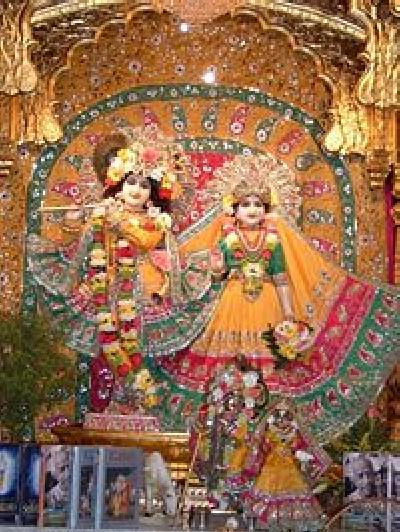 Krishna is associated with at least two divine consorts, several thousand lesser consorts, and also with his gopi lover Radha.
Krishna is associated with at least two divine consorts, several thousand lesser consorts, and also with his gopi lover Radha.
The legends of Krishna's life indicate that he was born on earth somewhere around 3,300-3,100BC. An evil prince named Kamsa had imprisoned his own father Ugrasena, the rightful king, and made himself king. One day a voice from heaven prophesied that Kamsa would be killed by the eighth son of Devak, Kamsa's sister. Kamsa was fond of Devak, so he sent her and her husband Vasudeva to prison instead of killing them. Lord Vishnu appeared to Devak and Vasudeva and told them that he would descend to earth as their eighth son, to kill Kamsa and destroy sin in the world. Kamsa killed Devak's first six sons, and Devak apparently miscarried her seventh pregnancy - though in fact the baby was transferred supernaturally to another woman, who gave birth to Krishna's brother Balarama.
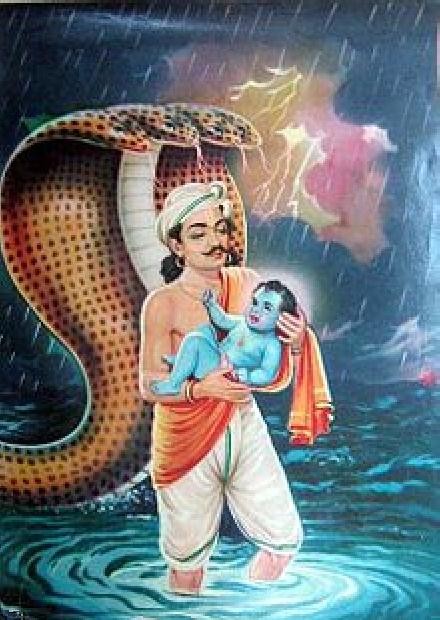 When Devak became pregnant again, Kamsa was in a quandary - would this be the seventh son, or the eighth? He decided to kill the baby; but Vasudeva knew of the plot, and got him out of the prison secretly, to be brought up by a foster-couple, Yasoda and Nanda.
When Devak became pregnant again, Kamsa was in a quandary - would this be the seventh son, or the eighth? He decided to kill the baby; but Vasudeva knew of the plot, and got him out of the prison secretly, to be brought up by a foster-couple, Yasoda and Nanda.
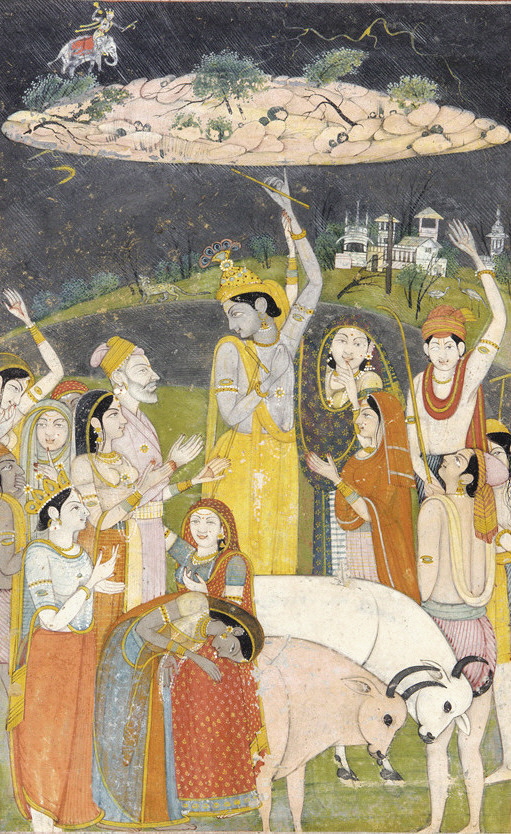 Nanda was chief of a village of cow-herders, and Krishna grew up among them. As a child he rescued the villagers from several dangers - a tornado demon, and a serpent who poisoned their river. Krishna displayed his superiority over Indra when he rescued the villagers from the wrath of Indra. Indra was going to punish the villagers for not worshipping him properly, because Krishna had told them that they should take care of their cows rather than sacrifice so many to Indra. Indra sent a great rain storm to destroy them - but Krishna lifted a mountain and held it above them to shelter them from the storm.
Nanda was chief of a village of cow-herders, and Krishna grew up among them. As a child he rescued the villagers from several dangers - a tornado demon, and a serpent who poisoned their river. Krishna displayed his superiority over Indra when he rescued the villagers from the wrath of Indra. Indra was going to punish the villagers for not worshipping him properly, because Krishna had told them that they should take care of their cows rather than sacrifice so many to Indra. Indra sent a great rain storm to destroy them - but Krishna lifted a mountain and held it above them to shelter them from the storm.
When he was a ten-year-old, Krishna returned to the court of Kamsa, killed him, set his parents free, reinstated Ugrasena as king, and settled down to life as a prince of the court. He mastered the 64 Arts and Sciences in 64 days. At this time he made friends with Prince Arjuna of the neighboring Pandava kingdom of Kuru. Krishna's elder brother Balarama became crown-prince in Ugrasena's kingdom, and Krishna founded a new kingdom at Dwaraka, an island in the sea (which was submerged during the wars of the Mahabharata).
Krishna married eight queens, including Rukmini, whom he abducted at her request in order to save her from a hated marriage. Then he rescued 16,000 girls from the demon Narakasura, and married them all to restore their honor. Vaishnava Hindus regard these multiple marriages as being reflections of Lakshmi, the consort of Vishnu.
![]()
Murugan or Kartikeya
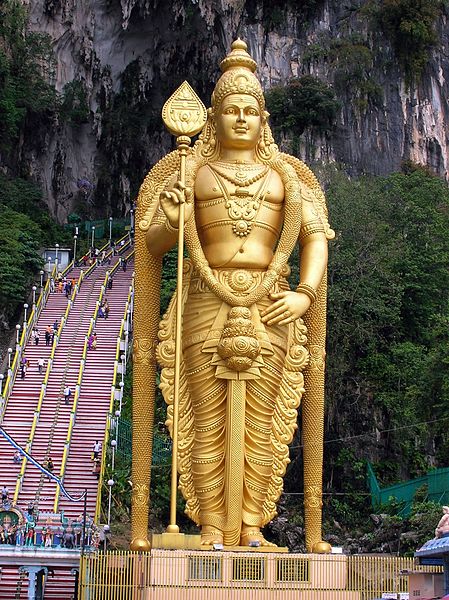 Murugan or Kartikeya or Skanda is the god of battlefields, war and victory. He has six heads and was nursed by six women.
Murugan or Kartikeya or Skanda is the god of battlefields, war and victory. He has six heads and was nursed by six women.
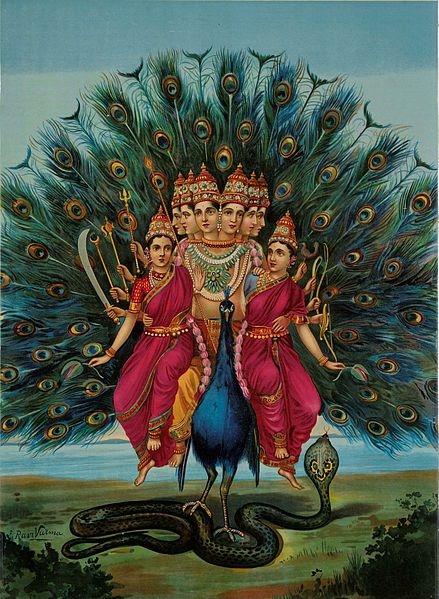 He is the Commander of the armies of the gods, and a son of Shiva and Parvati. His brother is Ganesha, and during their childhood they were often rivals for predominance. Some traditions believe him to be a form of Agni.
He is the Commander of the armies of the gods, and a son of Shiva and Parvati. His brother is Ganesha, and during their childhood they were often rivals for predominance. Some traditions believe him to be a form of Agni.
The story of the birth of Murugan is very complicated - Shiva was first married to Dakshayani, a granddaughter of Brahma. Dakshayani's mother did not like Shiva and insulted him publicly. As a result Dakshayana immolated herself in a Yagna ceremony (sacrifice to Agni), and Shiva was so enraged that he defiled the sacrifice - he broke the sacred vessels, insulted the priests, beheaded his mother-in-law, trampled on Indra, and scattered the assembled gods.

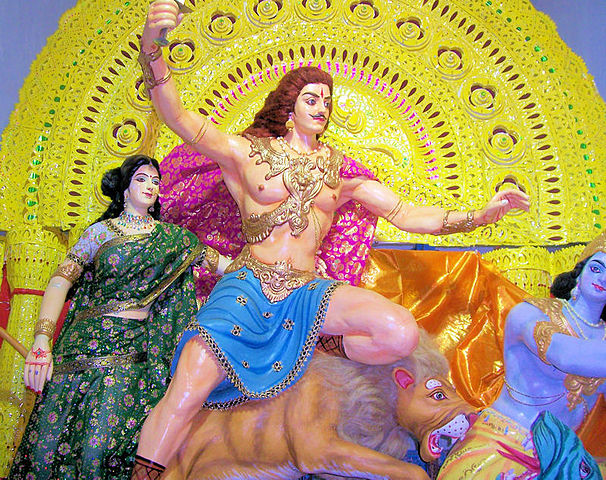 However, Dakshayana was reincarnated as Parvati, who eventually married Shiva and gave birth to Murugan.
However, Dakshayana was reincarnated as Parvati, who eventually married Shiva and gave birth to Murugan.
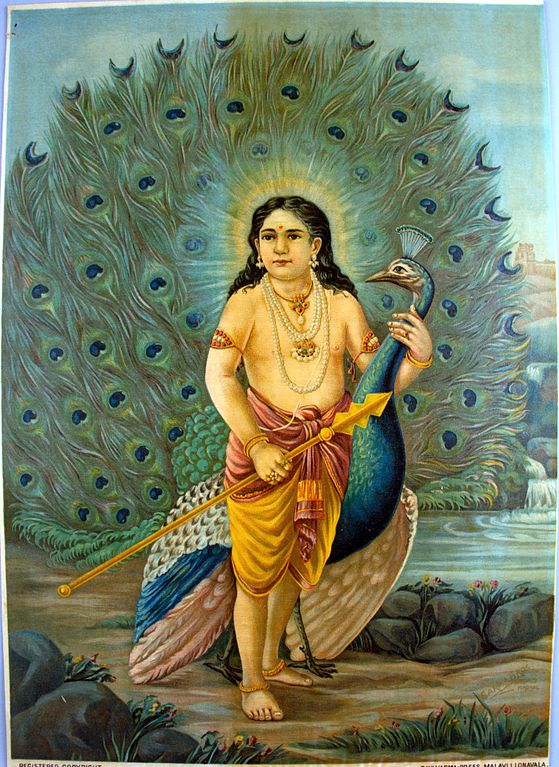 His weapons are the vel, and the bow and arrow, but he may also carry a sword, javelin, mace, or discus. He is carried or accompanied by a peacock
His weapons are the vel, and the bow and arrow, but he may also carry a sword, javelin, mace, or discus. He is carried or accompanied by a peacock
He has two wives, Valli (a human woman), and Deva, or Devasena (the daughter of Indra)
As Kartikaya, he is the god of male fertility and a good harvest.
A youthful version of him is worshiped as Balaskandha, the god of eternal youth.
![]()
Rama
 Rama, or Ramachandra, is the seventh avatar of Vishnu, and is a paragon of righteousness and justice. Rama is the central figure of the Ramayana epic poem, which gives an account of his descent to earth, his obedience to dharma, his ideals and his greatness. The Ramayana in its present form was written down by Rishi Valmiki, and tells the story of the trials and faithfulness of Rama.
Rama, or Ramachandra, is the seventh avatar of Vishnu, and is a paragon of righteousness and justice. Rama is the central figure of the Ramayana epic poem, which gives an account of his descent to earth, his obedience to dharma, his ideals and his greatness. The Ramayana in its present form was written down by Rishi Valmiki, and tells the story of the trials and faithfulness of Rama.
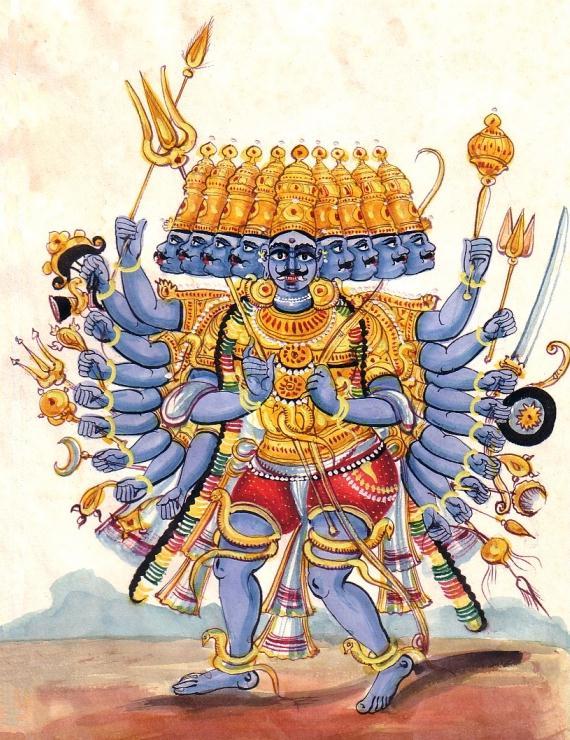 Before Rama was born, Ravanna, an evil demon with ten heads, had seized power over the earth and the heavens. He had been granted a wiish by Brahma, and had asked for protection from gods, other celestial beings, and demons, but had forgotten to ask for protection from human beings.
Before Rama was born, Ravanna, an evil demon with ten heads, had seized power over the earth and the heavens. He had been granted a wiish by Brahma, and had asked for protection from gods, other celestial beings, and demons, but had forgotten to ask for protection from human beings.
The earth goddess came to Brahma and begged him to deliver the earth from Ravanna's destructive rule, so Brahma and all the other gods went to Vishnu the Preserver, and asked him to intervene. Vishnu decided to descend to earth and be incarnate as a man in order to kill Ravana. The goddess Lakshmi decided that she too would descend to earth, and be incarnate as Sita in order to be with her consort. One legend recounts that Vishnu was cursed by the wife of a demon, and her curse was that he would be born on earth and live in doubt of his wife's chastity and purity all his life, he would be separated form her, and live a life of sadness and grief.
King Dasharatha of Ayodhaya had three queens, but was childless until he prayed and sacrificed. Then Agni the Fire God gave him a vial of a sacred drink for his wives. All three wives became pregnant and gave birth to four sons - Rama, Bharata, Lakshmana, and Shatrughna. Some texts say that an eagle carried a drop of the sacred drink to another lady who was under a curse, and who was praying that she would give birth to an incarnation of Shiva and be released from the curse. The Wind God gave her the sacred droplet, and she gave birth to Hanuman the monkey god.
The four sons of Dasharatha had many adventures, and grew to be exceptional young princes. The king decided to crown Rama as the crown prince. However, the mother of Bharata wanted her son to become the next ruler. She had saved the king's life some years previously, and the king had promised to grant her two wishes. She now demanded that the king grant her wish to send Rama into exile in the forest for fourteen years, and to crown Bharata instead of Rama. The king and his people did not wish to do this, but Rama said that a king must abide by his promises, and a son must obey his father. Consequently the king must send him into exile, and he must obey. Sita joined him in exile, saying that it was her duty as his wife.
 Rama's brother Lakshmana joined them rather than remain at the court. The king was heartbroken, and died six days later. Bharata did not want to rule in Rama's place, but Rama refused to return, saying that it was his duty to obey his dead father's edict of fourteen years of exile.
Rama's brother Lakshmana joined them rather than remain at the court. The king was heartbroken, and died six days later. Bharata did not want to rule in Rama's place, but Rama refused to return, saying that it was his duty to obey his dead father's edict of fourteen years of exile.
After several years in the forest, Sita was abducted by Ravana, who carried her off to the island of Lanka (Sri Lanka - Ceylon). Ravana kept Sita as a prisoner for more than a year, during which time she resisted the demon and kept her chastity.
Rama and Lakshmana searched for Sita, but did not know who had kidnapped her, or where she was kept. They enlisted the help of Hanuman the monkey-god.
Hanuman found where Sita was being held prisoner, but she would not let him try to free her because she knew that it was dharma for Rama to fight Ravana and kill him in order to free her. So Hanuman brought Rama and an army to set Sita free.
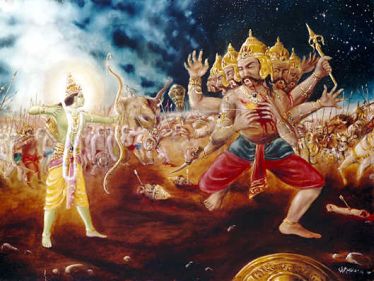
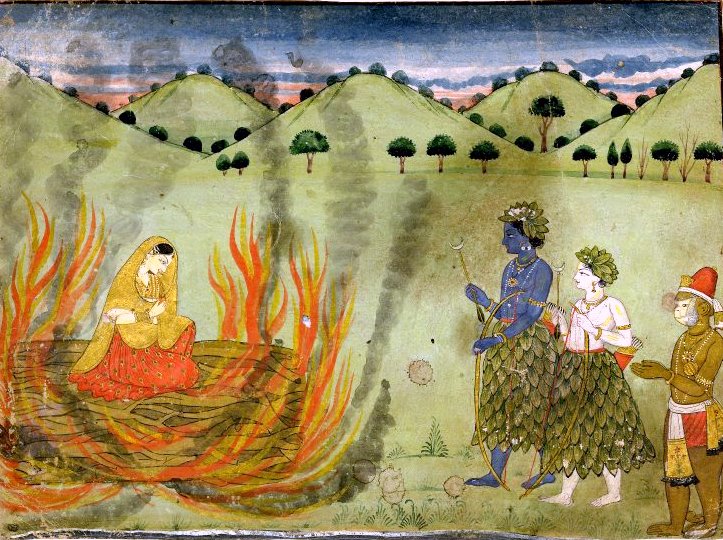 Rama killed Ravana, and Sita proved her chastity in an ordeal by fire, in which Agni, the god of fire, brought her through the flames to Rama.
Rama killed Ravana, and Sita proved her chastity in an ordeal by fire, in which Agni, the god of fire, brought her through the flames to Rama.
Rama, Sita, and Lakshmana returned to the kingdom, and Bharata ran to greet them and handed the throne back to Rama as the rightful king.
However, there were rumors that Sita had not been chaste, and Rama had to send her back to the exile in the forest, not knowing that she was pregnant with two sons to Rama.
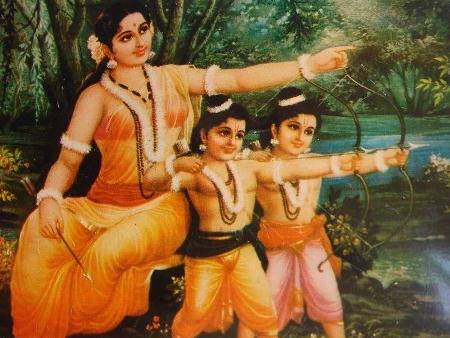 The twins were raised by Valmiki, a hermit who had seen what was to come, and who composed the Ramayana. He taught it to the two boys, and eventually Hanuman brought them to their father and they sang it to him.
The twins were raised by Valmiki, a hermit who had seen what was to come, and who composed the Ramayana. He taught it to the two boys, and eventually Hanuman brought them to their father and they sang it to him.
Some versions say that Rama died soon after that, still mourning for Sita. Other versions say that Rama ruled the whole earth for 11,000 years before abandoning his human body and returning to the heavens with Balarama. Rama's sons continued to live on earth and founded a dynasty of rulers.
Rama is usually depicted with some of the celestial weapons which were given to him - a jewel, a sword, armor, arrows, and the Bow of Vishnu (which took 5,000 strong men to pull it)
![]()
Shiva
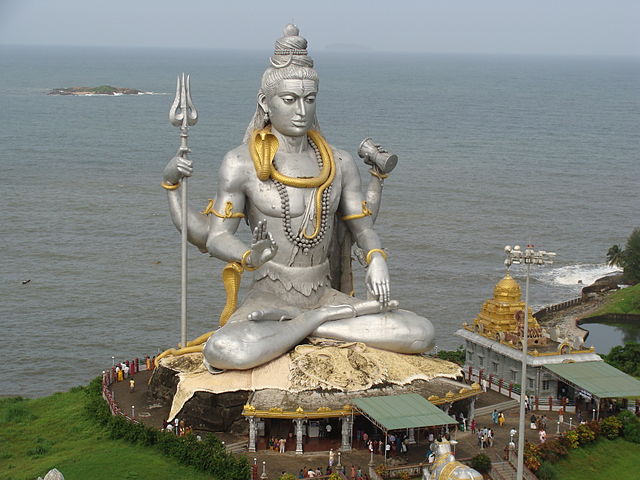 Shiva, the Auspicious one, is the Destroyer, and the most powerful of the gods. He destroys in order to re-create. He is a great ascetic, and also a great lover; a benevolent herdsman of souls, but also a great avenger. He is known by more than 100 names, including Mahadeva and Nataraja (the Cosmic Dancer). Shiva may be related to Rudra (the Vedic Storm God), or Agni (the Vedic Fire God). The Vedas, and later the Puranas, tended to identify Shiva as Agni.
Shiva, the Auspicious one, is the Destroyer, and the most powerful of the gods. He destroys in order to re-create. He is a great ascetic, and also a great lover; a benevolent herdsman of souls, but also a great avenger. He is known by more than 100 names, including Mahadeva and Nataraja (the Cosmic Dancer). Shiva may be related to Rudra (the Vedic Storm God), or Agni (the Vedic Fire God). The Vedas, and later the Puranas, tended to identify Shiva as Agni.
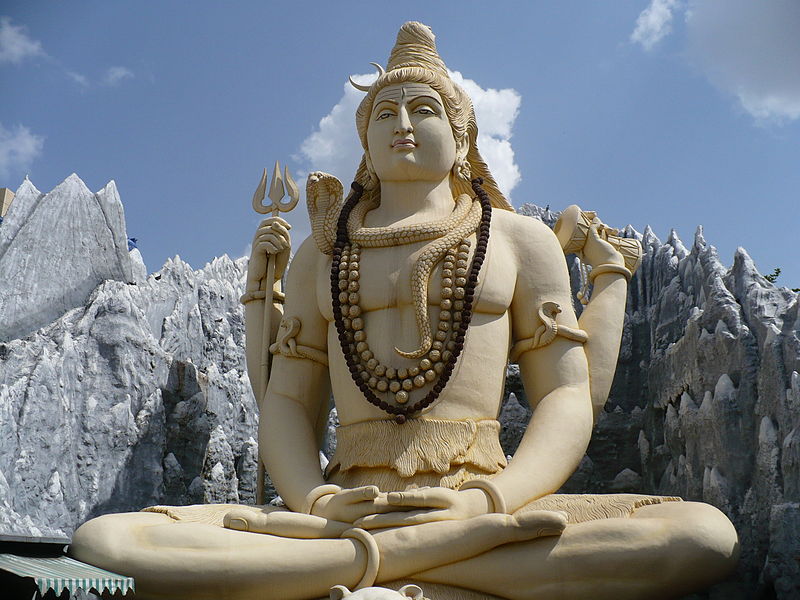
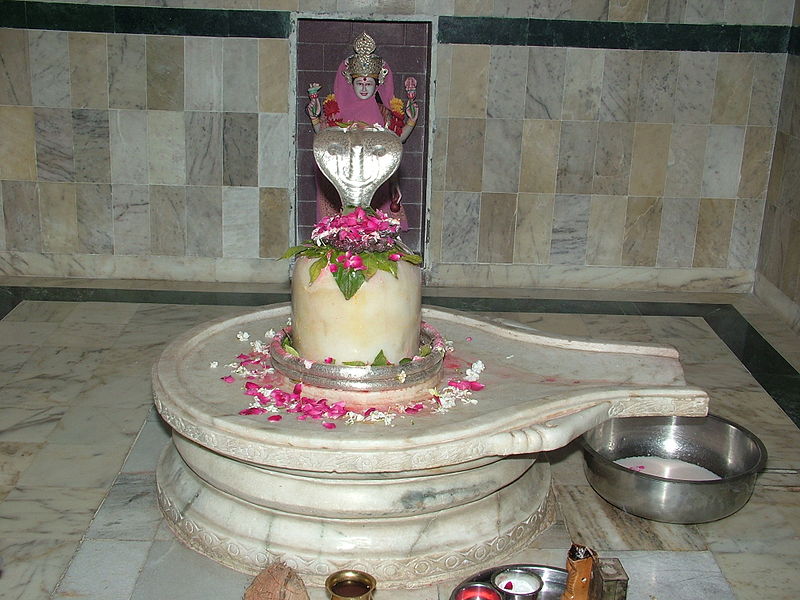 Shiva is often worshiped in the form of a linga - the phallic symbol of an erect penis.
Shiva is often worshiped in the form of a linga - the phallic symbol of an erect penis.
Shiva is usually depicted with his hair piled high on his head, decorated with a crescent moon, and with the River Ganges flowing out of his top-knot. His hair is sometimes described as matted, sometimes as coiled or braided. His third eye is on his forehead, and the cobra Vasuki coils around his neck, representing spiritual energy, and he holds a trishula (trident), a damaroo (small leather drum), and a pot of sacred water. He wears the Rudraksha beads, his body is covered with sacred ash. He sits on a tiger skin, or rides Nandi, his bull.
Shiva is sometimes shown with a blue throat - this refers to the occasion at the earliest time in the world, when the oceans churned up a poison which was going to kill the whole world. In order to save the world, Shiva drank the poison, and it was spreading into his body when Parvati strangled his neck in order to stop the poison spreading. So it stayed in his neck and turned it blue.
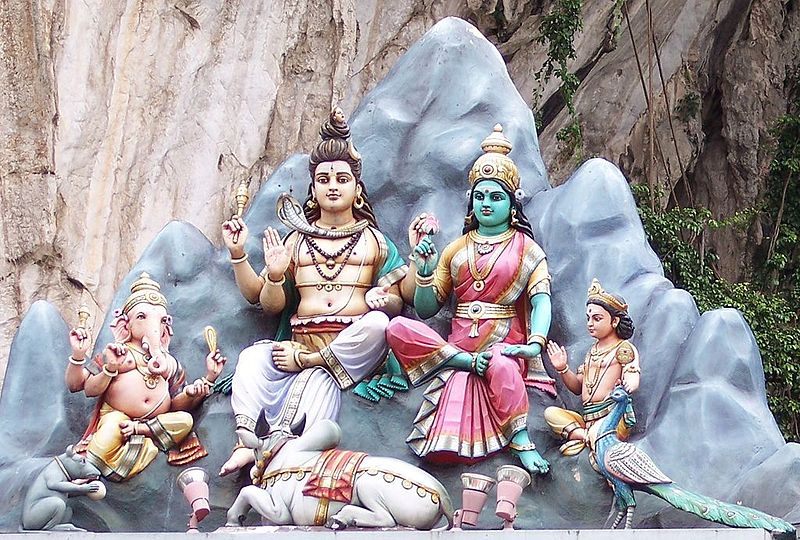
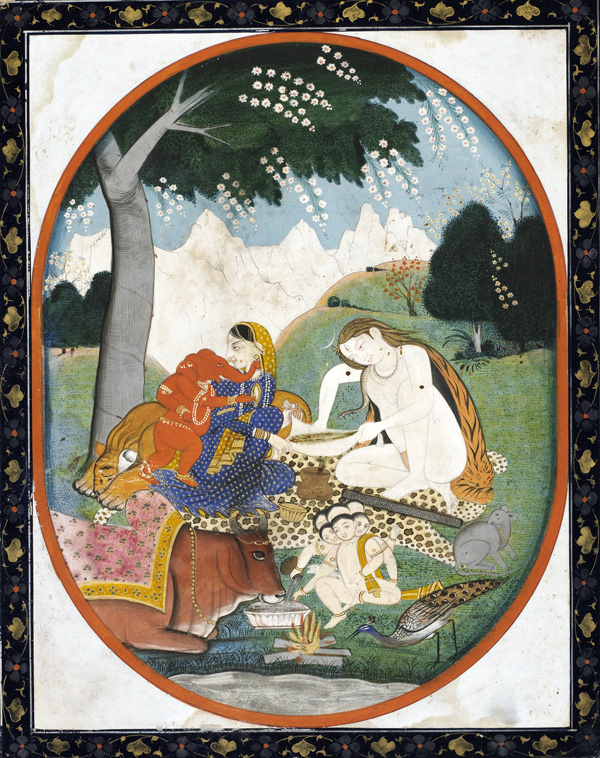 Shiva is often depicted with his wife Parvati, or with his family - Parvati and their two children, Ganesha and Kartikeya (or Murugan).
Shiva is often depicted with his wife Parvati, or with his family - Parvati and their two children, Ganesha and Kartikeya (or Murugan).
Shiva may also be depicted as Nataraja, the cosmic dancer. In this aspect he performs his "Five Activities" - Creation, Preservation, Destruction, Illusion. and Liberation. One hand holds the drum of Creation, one hand holds the fire of Destruction, his two lower hands are in the position signifying Preservation. A cobra is coiled around his forearm, another snake coils around his waist, and the crescent moon is on his forehead.
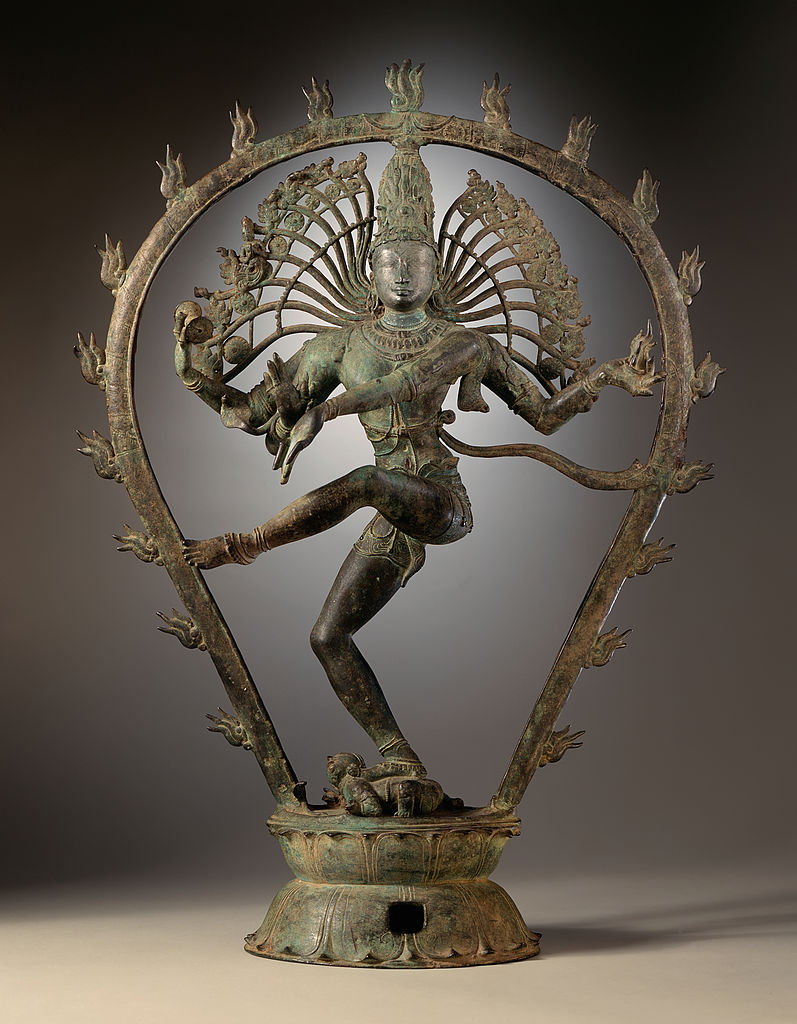 The demon of Forgetfulness crushed under his right foot represents Illusion, and his upraised left foot offers Liberation. The ring of flames of fire around him represents Cosmic Time.
The demon of Forgetfulness crushed under his right foot represents Illusion, and his upraised left foot offers Liberation. The ring of flames of fire around him represents Cosmic Time.
Although Shiva is the Destroyer, he destroys in order to rebuild and create, since death is the step to a new incarnation. So he combines the attributes of creation and destruction. To blunt his destructive forces he is fed with opium, and his male worshipers drink an intoxicant containing cannabis and milk.
His consort is known under several manifestations - as Parvati, Durga, or Kali, sometimes even as the supreme female goddess Shakti. Some depictions of Kali show Shiva lying beneath her feet - this implies that Shiva is motionless, lifeless, or inert without the power of Shakti. His consorts are the source of his divine energy.
![]()
Vishnu
Vishnu, also known as Narayana and Hari, is the Preserver or the Protector who acts with love for the world. He is the embodiment of mercy, compassion, benevolence, order, and truth, but he is also a warrior god, fighting against darkness and destruction.
He is portrayed as beautiful, with a charming smile, and with thick long hair from which flows the River Ganges, one of the sacred rivers.
![]() His skin is shown either as blue - to reflect the sky which watches over the earth, or as black to reflect the rain clouds which bring water for life. He has four arms, which support the four directions of the cosmos. The two front arms represent his actions in the physical world. The two arms in the back represent his actions in the spiritual world.
His skin is shown either as blue - to reflect the sky which watches over the earth, or as black to reflect the rain clouds which bring water for life. He has four arms, which support the four directions of the cosmos. The two front arms represent his actions in the physical world. The two arms in the back represent his actions in the spiritual world.
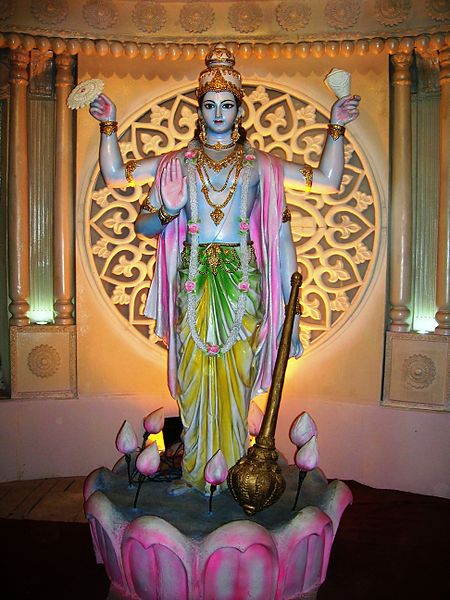 He holds a shankha (conch shell trumpet) which makes the sacred aum sound with power to create and maintain the universe; a chakra (discus-shaped weapon which beheads enemies), which represents a pure spiritual mind; a padma (lotus flower) which represents spiritual liberation, purity, and divine perfection; a bow and arrows (representing intellectual acuity); and a gada (mace) which represents spiritual, mental, and physical strength. One hand may be raised in blessing. He stands or sits on a lotus flower. His robes are usually bright yellow, to symbolize the light and warmth of life. He wears earrings in the shape of the mythical Makara sea-monster (part fish, part goat, part elephant) which symbolize the rites of conception. He wears a jewel like the sun, either in his crown or on a necklace, which has the power to fulfill the wishes of his worshippers. He wears armlets which represent the three aims of life - righteousness, success, and pleasure There may also be a peacock feather in his crown.
He holds a shankha (conch shell trumpet) which makes the sacred aum sound with power to create and maintain the universe; a chakra (discus-shaped weapon which beheads enemies), which represents a pure spiritual mind; a padma (lotus flower) which represents spiritual liberation, purity, and divine perfection; a bow and arrows (representing intellectual acuity); and a gada (mace) which represents spiritual, mental, and physical strength. One hand may be raised in blessing. He stands or sits on a lotus flower. His robes are usually bright yellow, to symbolize the light and warmth of life. He wears earrings in the shape of the mythical Makara sea-monster (part fish, part goat, part elephant) which symbolize the rites of conception. He wears a jewel like the sun, either in his crown or on a necklace, which has the power to fulfill the wishes of his worshippers. He wears armlets which represent the three aims of life - righteousness, success, and pleasure There may also be a peacock feather in his crown.
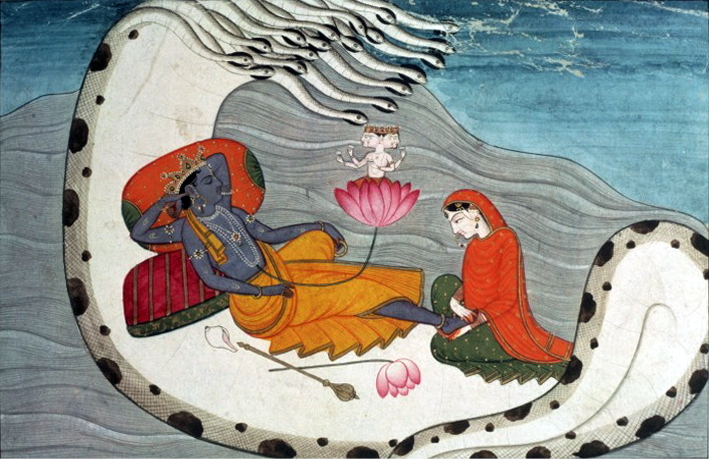 He wears two garlands, one of jewels to celebrate his victories over demons, and one of wild flowers to show his love for the earth. Other traditions give him five garlands, for the five senses.
He wears two garlands, one of jewels to celebrate his victories over demons, and one of wild flowers to show his love for the earth. Other traditions give him five garlands, for the five senses.
Some representations may show the River Ganges flowing from his hair, or the god Brahma sitting on a lotus which grows from Vishnu's navel.
![]() Vishnu may be shown reclining on the great serpent, floating on the Ocean of Milk, with his consort Lakshmi massaging his feet.
Vishnu may be shown reclining on the great serpent, floating on the Ocean of Milk, with his consort Lakshmi massaging his feet.
![]() Vishnu acts supernaturally to preserve the order of the world. He acts by means of "avatars".
An avatar is a "descent" of god to earth in physical form, with the specific goal of aiding the world. Vishnu has ten Avatars - nine have already appeared, and the tenth, Kalki, will arrive at the end of this present age to bring an era of peace. The ten great avatars of Vishnu are
Vishnu acts supernaturally to preserve the order of the world. He acts by means of "avatars".
An avatar is a "descent" of god to earth in physical form, with the specific goal of aiding the world. Vishnu has ten Avatars - nine have already appeared, and the tenth, Kalki, will arrive at the end of this present age to bring an era of peace. The ten great avatars of Vishnu are
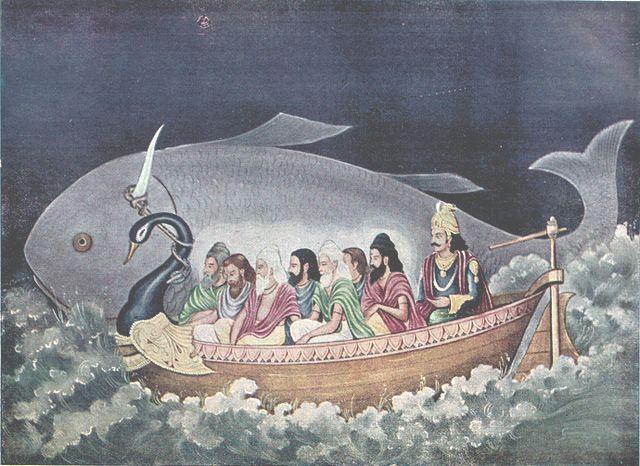 Matsya - the fish that saved Manu (the first Man) and the human race, by guiding their boat to safety when there was a Great Deluge.
Matsya - the fish that saved Manu (the first Man) and the human race, by guiding their boat to safety when there was a Great Deluge.- Kurma - a tortoise that helped churn the Ocean of Milk so that the Devas could drink the nectar of immortality .
- Varaha - a boar that rescued the earth.
- Narasimha - a lion-man who defeated a demon.
- Vamana - a dwarf who grew into a giant and saved the world from an evil king.
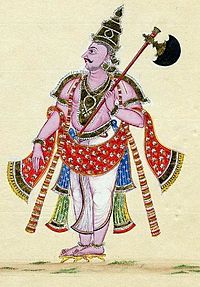 Parashurama - a human warrior who drove the seas from the dry land and was granted immortality.
Parashurama - a human warrior who drove the seas from the dry land and was granted immortality.- Rama - the hero of the Ramayana.
- Balarama - the brother of Rama.
- Krishna.
- Kalki - the final one is yet to come. He will be a man on a white horse, and will introduce the end of this world.
Some traditions hold that the Buddha was an avatar of Vishnu.
Vishnu's weapons are the chakra (disc), gada (mace), shankha, and sword. The story of the origin of his mace is that there was a "good" demon named Gada. Vishnu asked Gada to give him his bones, and Gada tore himself apart; his flesh turned into metals - gold, silver, copper, iron, and tine - and his bones became Vishnu's mace.
Vishnu is associated with wind instruments - he plays the flute to delight his worshippers, and blows his conch to warn the wicked. He is associated with the cobra, who protects him and represents endless time; and with the eagle Garuda who joins in battle against the forces of chaos and corruption.
His consort is Lakshmi, with whom he is deeply in love.
![]()
Devi
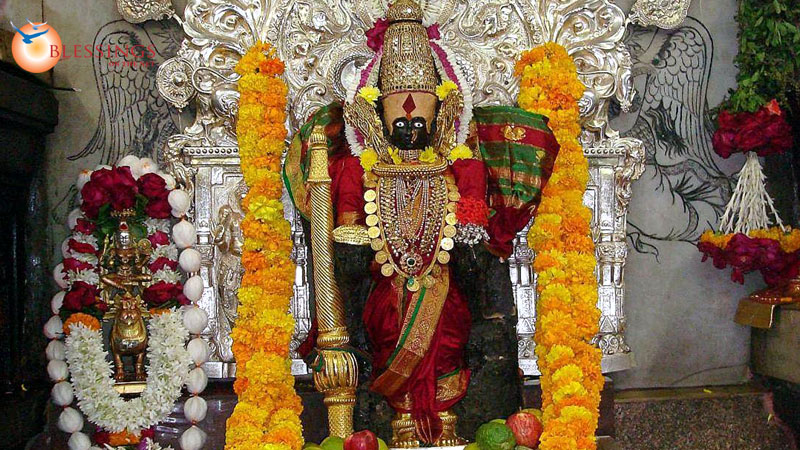 Devi is the Great Mother goddess. Her name just means "goddess". She is one of the most ancient deities of India, and different regions of India worship her under different names and focus on different aspects of her divinity. She is primarily associated with fertility, crops, and the earth. Although she has a loving personality as Mother and Giver of Life, she also has a violent personality as Bringer of Death and Warrior against evil.
Devi is the Great Mother goddess. Her name just means "goddess". She is one of the most ancient deities of India, and different regions of India worship her under different names and focus on different aspects of her divinity. She is primarily associated with fertility, crops, and the earth. Although she has a loving personality as Mother and Giver of Life, she also has a violent personality as Bringer of Death and Warrior against evil.
She has eight arms, holds a sword, and rides a tiger. She wears a bindi (dot) on the forehead.
Devi is the consort of Shiva.
The various aspects of Devi gave rise to further powerful goddesses, which have now taken on their own identities, particularly Durga (the Mother, the Destroyer), Parvati (the Wife - fertility, love, devotion), Lakshmi (the Bride - wealth, prosperity), and Kali (the Destroyer). All of them are consorts of Shiva.
Some Hindu traditions claim that Devi is the Brahman (Ultimate Reality) in female form and that it is her energy that empowers Brahma, Vishnu and Shiva.
![]()
Durga
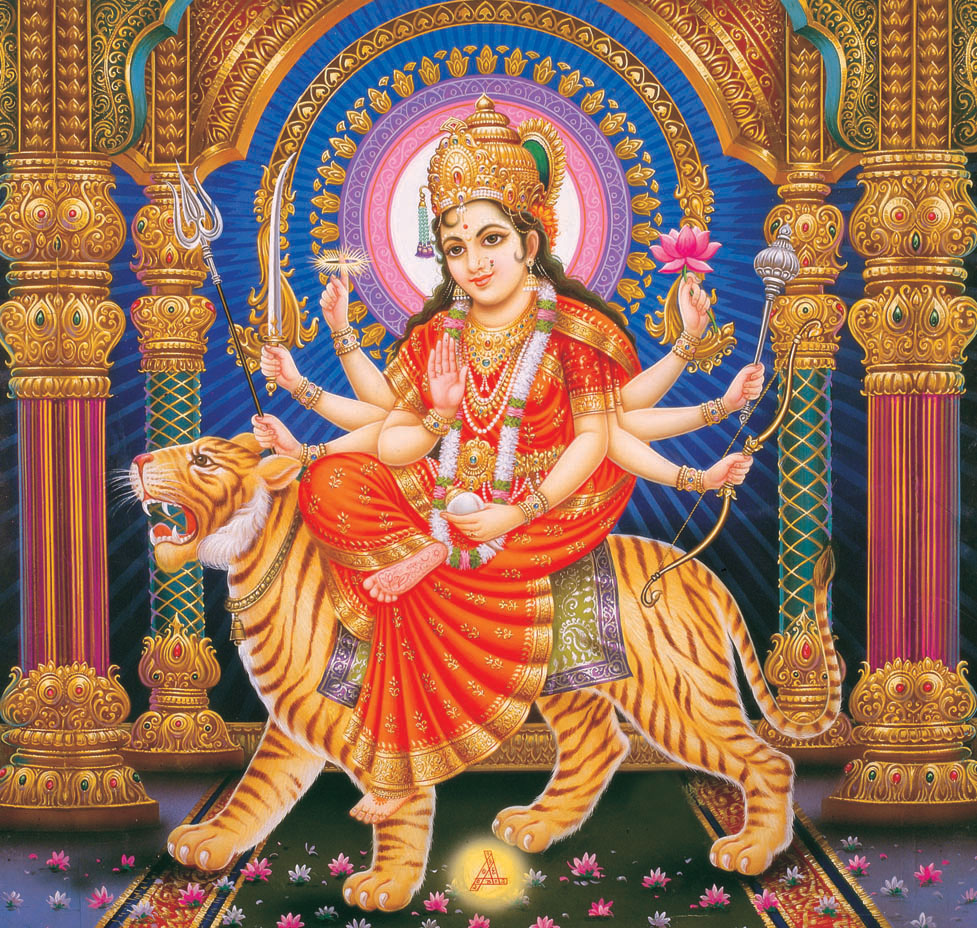 Durga (the Invincible) has become the principal form of the Mother Goddess.
Durga (the Invincible) has become the principal form of the Mother Goddess.
The Shaktism branch of Hinduism regards Devi as the Supreme Being, and Durga as the cause of creation and destruction. Shakti is regarded as pure energy, without form. One account of her origin (the Shiva Purana) states that Shiva invoked her from the energy of his left half, and then the pair of them created Brahma and Vishnu.
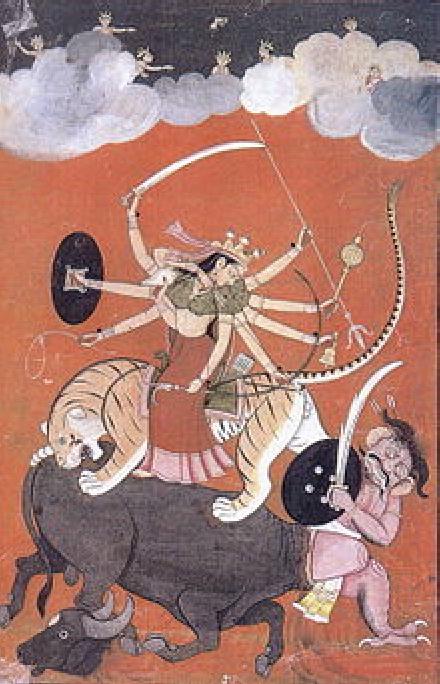 Durga is a warrior goddess who personifies the victory of good over evil. At one time the demon Mahish terrorized the universe - so Durga manifested herself and went into battle against him. The demon turned into a buffalo an attacked her, so she tied him up with ropes. Then the demon turned himself into a lion and sprang at her, so she chopped his head off with her sword. She pinned him down with her arrows, but he turned himself into an elephant and attacked her mount. She chopped off the elephant's trunk, and the elephant turned into a buffalo again, but she used her trident to kill and behead the demon.
Durga is a warrior goddess who personifies the victory of good over evil. At one time the demon Mahish terrorized the universe - so Durga manifested herself and went into battle against him. The demon turned into a buffalo an attacked her, so she tied him up with ropes. Then the demon turned himself into a lion and sprang at her, so she chopped his head off with her sword. She pinned him down with her arrows, but he turned himself into an elephant and attacked her mount. She chopped off the elephant's trunk, and the elephant turned into a buffalo again, but she used her trident to kill and behead the demon.
 Durga is depicted dressed in red and riding on a tiger (or sometimes a lion). She usually has 8 arms which carry an array of weapons.
Durga is depicted dressed in red and riding on a tiger (or sometimes a lion). She usually has 8 arms which carry an array of weapons.
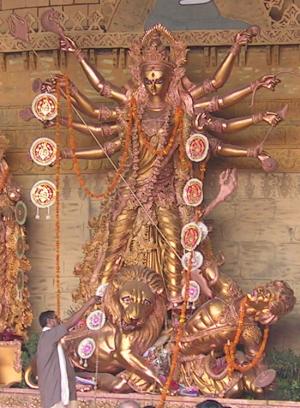 The chakra (discus) was given to her by Marayana, and represents dharma or righteousness; she spins it on her finger and uses it to destroy evil and protect righteousness. The conch shell was given to her by Varuna, and sounds the Aum syllable - this is the sound of creation and destroys negative forces and brings peace to those who pray to her. The bow and arrows were given to her by Vayu, and she uses them to destroy difficulties encountered in the lives of her worshipers. Her sword represents knowledge and intelligence, and she uses it to remove ignorance and bad karma from her worshippers. Her spear destroys evil forces. Her club or mace destroys the power of enemies over her worshippers.
The chakra (discus) was given to her by Marayana, and represents dharma or righteousness; she spins it on her finger and uses it to destroy evil and protect righteousness. The conch shell was given to her by Varuna, and sounds the Aum syllable - this is the sound of creation and destroys negative forces and brings peace to those who pray to her. The bow and arrows were given to her by Vayu, and she uses them to destroy difficulties encountered in the lives of her worshipers. Her sword represents knowledge and intelligence, and she uses it to remove ignorance and bad karma from her worshippers. Her spear destroys evil forces. Her club or mace destroys the power of enemies over her worshippers.
 Her trident was given to her by Shiva and represents the balance of qualities in a person; it gives her worshippers power to fight the darker aspects of their lives. The thunderbolt was given to her by Indra, and represents firmness of spirit and a strong will. The lotus bud which she holds represents the awakening of spiritual consciousness which she grants to her worshippers. She may also carry other articles such as a chakra, a lasso or rope, a battle-axe, a dagger, or an elephant goad, a shield, a snake, a goblet, or a bell.
Her trident was given to her by Shiva and represents the balance of qualities in a person; it gives her worshippers power to fight the darker aspects of their lives. The thunderbolt was given to her by Indra, and represents firmness of spirit and a strong will. The lotus bud which she holds represents the awakening of spiritual consciousness which she grants to her worshippers. She may also carry other articles such as a chakra, a lasso or rope, a battle-axe, a dagger, or an elephant goad, a shield, a snake, a goblet, or a bell.
She is a consort of Shiva.
![]()
Kali
 Kali is an aspect of the Mother Goddess. She is the goddess of time, power, change, destruction and creation. In some aspects she is formless, raw essential chaotic energy which transcends time itself, the ultimate Mother of the Universe.
Kali is an aspect of the Mother Goddess. She is the goddess of time, power, change, destruction and creation. In some aspects she is formless, raw essential chaotic energy which transcends time itself, the ultimate Mother of the Universe.
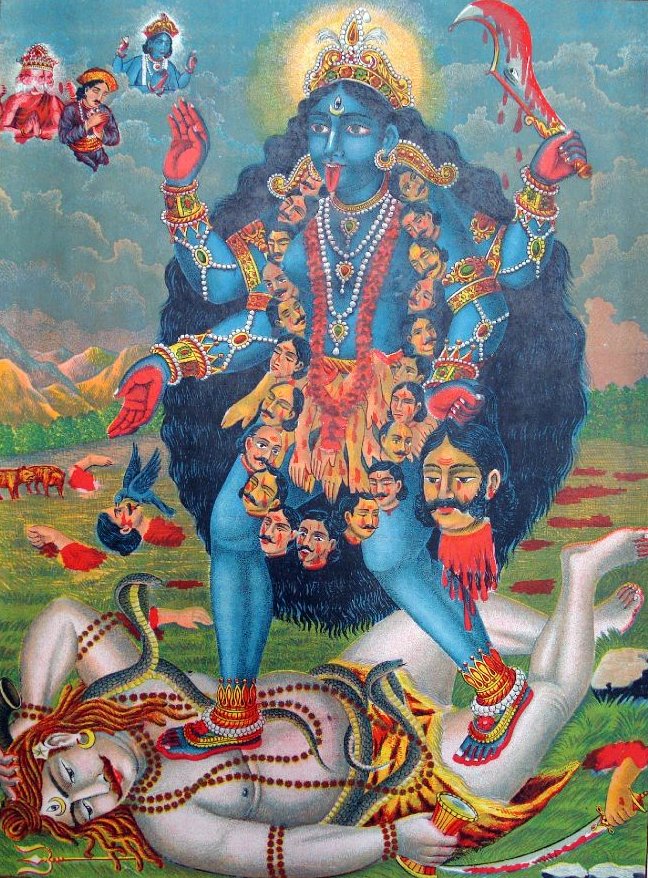 One legend of her origin says that when Durga fought against the demon Mahishasura, Durga's rage became so intense that it burst out of her forehead in the form of Kali. Kali then went on the rampage and ate all the demons. She took their heads and strung them as a necklace, which she wears. After killing the demons Kali went on a killing spree was terrorizing the whole earth until Shiva lay down before her. When she realized whom she was standing upon she came to her senses and calmed down.
One legend of her origin says that when Durga fought against the demon Mahishasura, Durga's rage became so intense that it burst out of her forehead in the form of Kali. Kali then went on the rampage and ate all the demons. She took their heads and strung them as a necklace, which she wears. After killing the demons Kali went on a killing spree was terrorizing the whole earth until Shiva lay down before her. When she realized whom she was standing upon she came to her senses and calmed down.
Another version of Kali's origin is she was formed to conquer the demon Daruka, who could only be killed by a woman. The rest of the gods asked Parvati to deal with Daruka. Parvati leapt into Shiva's throat because there was some poison there which he had swallowed to remove it from the earth. Parvati was transformed into Kali by the poison, leapt out of Shiva's throat and went and killed the demon.
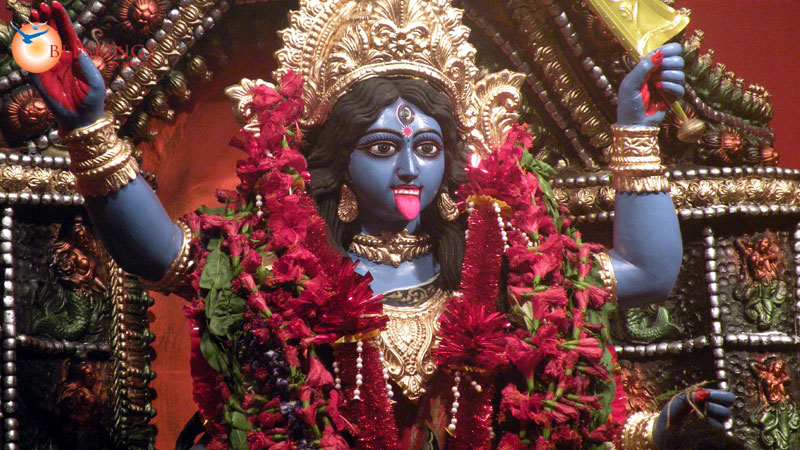 Another version of Kali's origin tells of the demon Raktabija. The gods were having trouble dealing with Raktabija because if any drop of his blood fell to the ground it produced more demons, so their attempts to kill him were only making things worse. Eventually all the gods got together and combined their divine energies to produce one super-being - and this was Kali. Kali swallowed all the demons on Daruka's army, without spilling any blood, then she cut off Daruka's head with a sword and drank all his blood without spilling any. Some accounts say it was Durga who produced Kali when she and the other gods were fighting Raktabija - Durga got so enraged that she gave out a fire-ball of energy which burst to reveal Kali. Sometimes Kali is shown carrying a bowl made out of a skull, containing the blood of Raktabija.
Another version of Kali's origin tells of the demon Raktabija. The gods were having trouble dealing with Raktabija because if any drop of his blood fell to the ground it produced more demons, so their attempts to kill him were only making things worse. Eventually all the gods got together and combined their divine energies to produce one super-being - and this was Kali. Kali swallowed all the demons on Daruka's army, without spilling any blood, then she cut off Daruka's head with a sword and drank all his blood without spilling any. Some accounts say it was Durga who produced Kali when she and the other gods were fighting Raktabija - Durga got so enraged that she gave out a fire-ball of energy which burst to reveal Kali. Sometimes Kali is shown carrying a bowl made out of a skull, containing the blood of Raktabija.

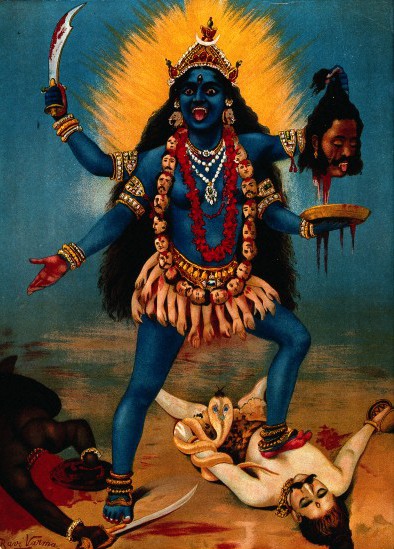 She is portrayed with a blue or black skin, and is often shown dancing or standing on the body of her consort, Shiva. Her mouth is agape, her extended tongue and her hands are covered with blood. and her eyes are red with rage. She wears a necklace of skulls or heads, earrings made from the corpses of children, bracelets, armbands or garlands of cobras, a tiger-skin for a garment, and a skirt of severed forearms. There are 50 heads on her necklace, symbolizing the 50 characters of the sanskrit alphabet - she is the mother of knowledge and writing. She carries weapons - scimitar, khanda (sword), and trishul (trident), noose, and a staff topped with a skull. She often holds a severed head in one hand.
She is portrayed with a blue or black skin, and is often shown dancing or standing on the body of her consort, Shiva. Her mouth is agape, her extended tongue and her hands are covered with blood. and her eyes are red with rage. She wears a necklace of skulls or heads, earrings made from the corpses of children, bracelets, armbands or garlands of cobras, a tiger-skin for a garment, and a skirt of severed forearms. There are 50 heads on her necklace, symbolizing the 50 characters of the sanskrit alphabet - she is the mother of knowledge and writing. She carries weapons - scimitar, khanda (sword), and trishul (trident), noose, and a staff topped with a skull. She often holds a severed head in one hand.
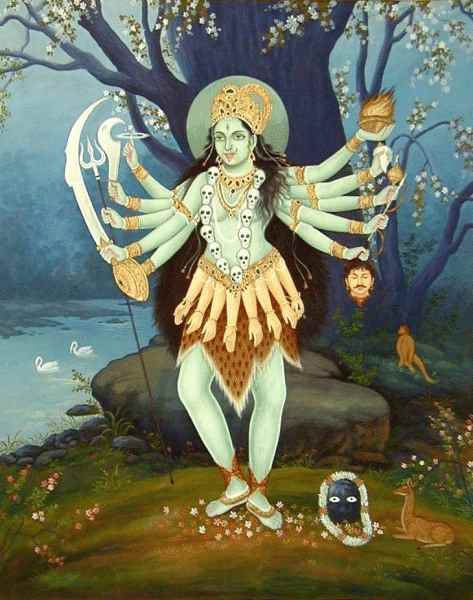 Sometimes Kali is portrayed with ten heads, ten arms, and ten legs. She may also be shown with a third eye in her forehead - her three eyes represent her supremacy over time - past, present, and future.
Sometimes Kali is portrayed with ten heads, ten arms, and ten legs. She may also be shown with a third eye in her forehead - her three eyes represent her supremacy over time - past, present, and future.
She rides a lion or tiger.
Kali is the consort of Shiva, with whom she copulates to produce the universe.
![]()
Lakshmi
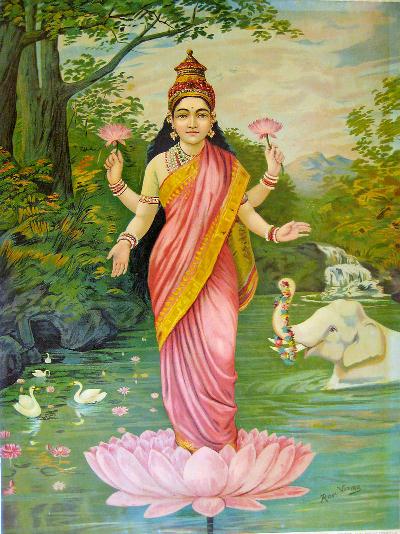 Lakshmi is the goddess of light, fortune, wealth, power, beauty, and prosperity. She personifies happiness, charm, and grace. She has four arms, which represent the four goals of human life - dharma (a life of morality and ethics), kama (the pursuit of love), artha (the pursuit of wealth), and moksha (the pursuit of self-knowledge and liberation).
Lakshmi is the goddess of light, fortune, wealth, power, beauty, and prosperity. She personifies happiness, charm, and grace. She has four arms, which represent the four goals of human life - dharma (a life of morality and ethics), kama (the pursuit of love), artha (the pursuit of wealth), and moksha (the pursuit of self-knowledge and liberation).
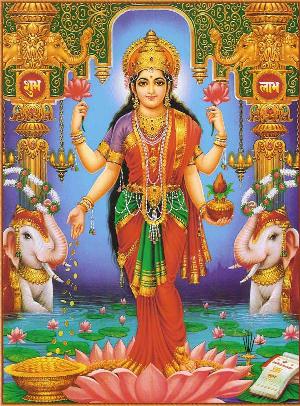 She sits or stands on a lotus flower, and carries a red lotus on one or two hands. She is accompanied by one or a pair of elephants, who symbolize strength, work, activity, and fertility. The elephants may spray water from their upraised trunks, symbolizing the wealth of fertility in rain and food. Sometimes she is accompanied by an owl, symbolizing the patient search for knowledge. Some representations show wealth as money falling from her hand, or as a jar of money in one hand. Her open hands are in the mudra (ritual position) denoting compassion and charity. She is usually clothed in red decorated with gold - further signs of beauty and wealth. Other pictures show her with 16 or 18 arms, holding a variety of articles, and sitting on a lion or a tiger.
She sits or stands on a lotus flower, and carries a red lotus on one or two hands. She is accompanied by one or a pair of elephants, who symbolize strength, work, activity, and fertility. The elephants may spray water from their upraised trunks, symbolizing the wealth of fertility in rain and food. Sometimes she is accompanied by an owl, symbolizing the patient search for knowledge. Some representations show wealth as money falling from her hand, or as a jar of money in one hand. Her open hands are in the mudra (ritual position) denoting compassion and charity. She is usually clothed in red decorated with gold - further signs of beauty and wealth. Other pictures show her with 16 or 18 arms, holding a variety of articles, and sitting on a lion or a tiger.
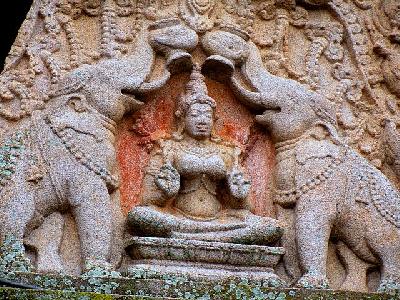 Lakshmi developed out of the Vedic goddess Sri. According to one legend, when the universe was being created, she emerged on a lotus flower floating on the primal waters.
Lakshmi developed out of the Vedic goddess Sri. According to one legend, when the universe was being created, she emerged on a lotus flower floating on the primal waters.
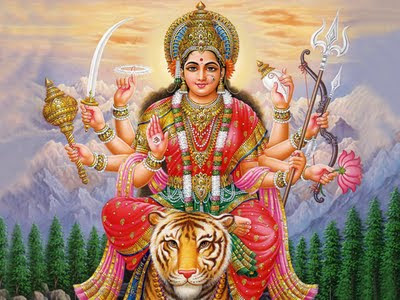 Another version says that when the gods and demons were churning the Ocean of Milk, Lakshmi emerged from the foam, holding a lotus flower in her hand; she was given the choice of joining the devas (gods) or the asuras (demons). She chose to join the devas, and chose to be with Vishnu. Sometimes she is referred to as Padma - Lotus.
Another version says that when the gods and demons were churning the Ocean of Milk, Lakshmi emerged from the foam, holding a lotus flower in her hand; she was given the choice of joining the devas (gods) or the asuras (demons). She chose to join the devas, and chose to be with Vishnu. Sometimes she is referred to as Padma - Lotus.
Lakshmi is the consort of Vishnu, for whom she provides the active energy. When Vishnu descended to earth as the avatars Rama and Krishna, Lakshmi also descended to earth and became Sita (Rama's wife) and Rukmini (Krishna's wife). The relationship of Vishnu and Lakshmi is the model for Hindu weddings and marriages. Some of the Hindu scriptures declare that all women are embodiments of Lakshmi.
Lakshmi will only dwell in a home which is clean, and where the people are hard-working.
The festival of Diwali is celebrated in Lakshmi's honor.
![]()
Parvati
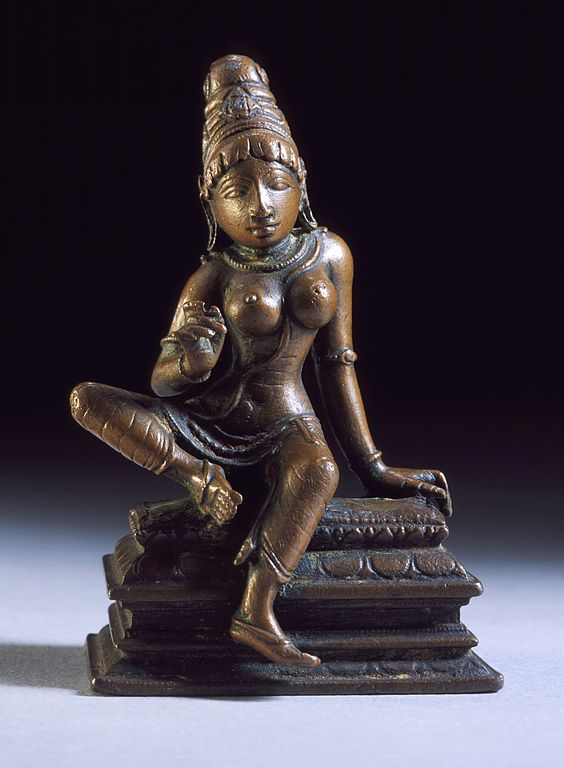 Parvati is the goddess of fertility, devotion, courage, and love. She personifies the nurturing aspect of the Mother Goddess Shakti.
Together with the goddesses Lakshmi and Sarawati, Parvati is part of the Tridevi (the trinity of Hindu goddesses). She has divine power and strength, and is the consort of Shiva. Parvati is an avatar of Devi - she was born on earth in order to woo and win Shiva.
Parvati is the goddess of fertility, devotion, courage, and love. She personifies the nurturing aspect of the Mother Goddess Shakti.
Together with the goddesses Lakshmi and Sarawati, Parvati is part of the Tridevi (the trinity of Hindu goddesses). She has divine power and strength, and is the consort of Shiva. Parvati is an avatar of Devi - she was born on earth in order to woo and win Shiva.
The story goes that the King of the Mountains (the Himalayas) had a daughter, Sati, who married Shiva against her father's wishes. Her father did not like Shiva, and did not invite him to a yagna (fire sacrifice) that he was performing. At this insult to her lover, Parvati threw herself into the sacrificial fire, and Shiva flew into a rage. Sati was then reincarnated as Parvati and married Shiva.
 Parvati and Shiva are the parents of Ganesha and Murugan (aka. Kartikeya, Skanda). Some traditions hold her to be the sister of Vishnu.
Parvati and Shiva are the parents of Ganesha and Murugan (aka. Kartikeya, Skanda). Some traditions hold her to be the sister of Vishnu.
She is usually depicted with a red sari and head-band, and may have two or four arms or even more. She may hold a nandi, trident, chakra, gada, padan, conch, crown, lotus, mirror, beads, bell, goad, sugar-cane, cross-bow, or khadag. She is often shown holding Ganesha, while Murugan plays at her feet.
She rides on a lion, a tiger, or a bull, and is sometimes accompanied by a parrot, representing cheerful love-talk and fertility.
![]()
Saraswati
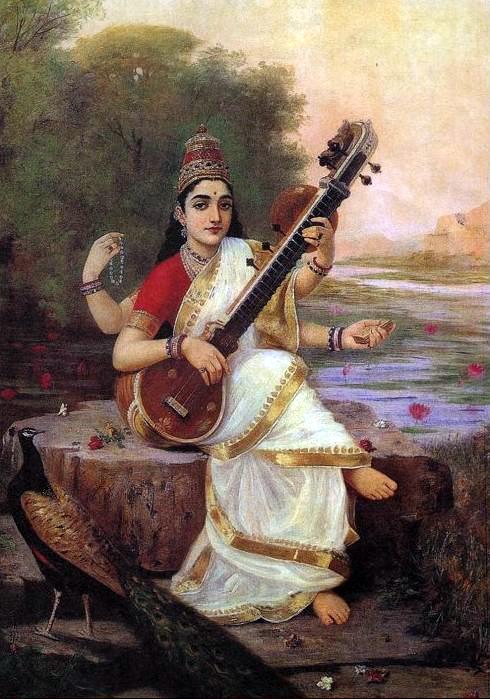 Saraswati was originally a Vedic River goddess. She is the goddess of speech, learning, wisdom, and the arts.
Saraswati was originally a Vedic River goddess. She is the goddess of speech, learning, wisdom, and the arts.
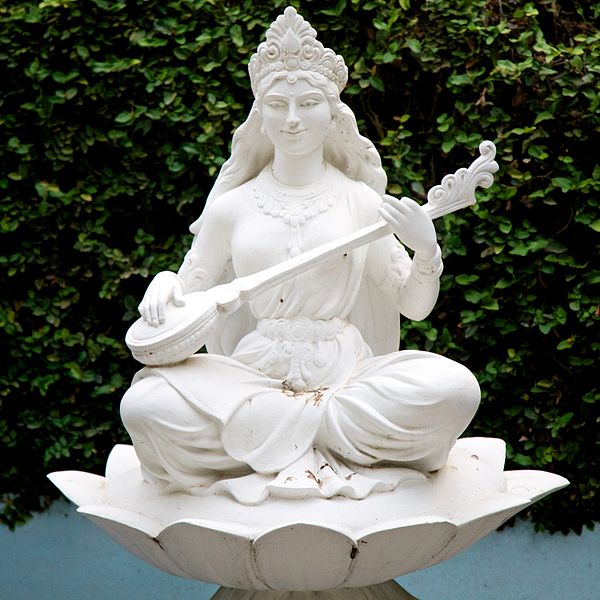 She is regarded as the mother of the Vedas. Some accounts say the she was born from the mind of Brahma; others say that she is a daughter of Shiva and Durga.
She is regarded as the mother of the Vedas. Some accounts say the she was born from the mind of Brahma; others say that she is a daughter of Shiva and Durga.
Saraswati and Indra killed a serpent who was hording all the earth's water, so she is associated with rivers and water.
She is usually depicted wearing white, with a white lotus, she holds prayer-beads in one hand, a pot of water or soma in another, the Vedas in another, and plays a Veena, representing learning and the arts. Her birds are the swan and the peacock.
Saraswati is the consort of Brahma, though sometimes she is associated with Shiva or Ganesha. One legend tells that Vishnu had three wives - Lakshmi, Ganga (the goddess of the River Ganges), and Saraswati. The wives quarreled constantly with each other, so Vishnu gave Ganga to Shiva, Saraswati to Brahma, and kept Lakshmi for himself.
![]()
Shakti
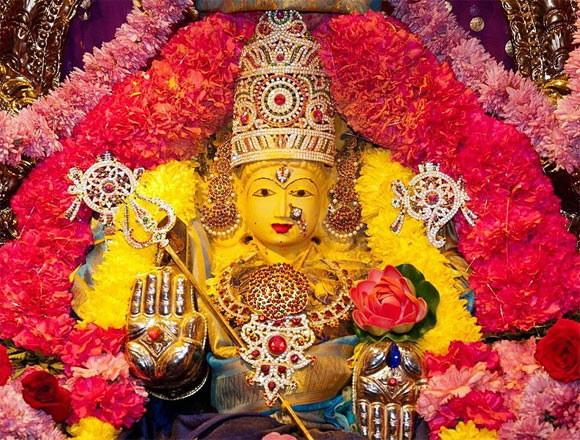 Shakti represents the divine cosmic energy - the dynamic force of the universe. She is also a form of the Mother Goddess, and is sometimes identified as Parvati.
Shakti represents the divine cosmic energy - the dynamic force of the universe. She is also a form of the Mother Goddess, and is sometimes identified as Parvati.
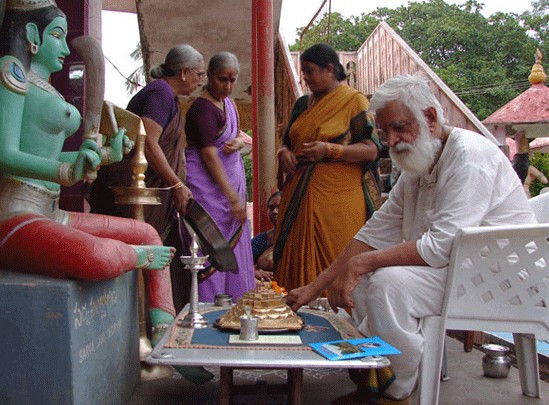 Many villages in the southern parts of India regard Shakti as their deity and protector.
Many villages in the southern parts of India regard Shakti as their deity and protector.
![]()
Apsaras
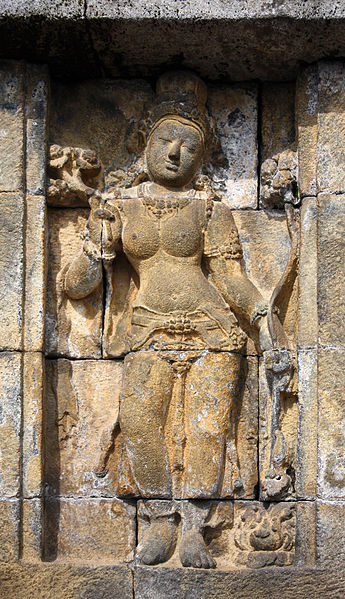 Apsaras are female spirits of the waters, clouds, and air (some of them can fly). They appear to be beautiful young women with large breasts, wide hips, and narrow waists. They are exotic dancers, and often seduce gods or men. Sometimes the gods sent them to seduce holy men who were becoming so powerful spiritually that the gods felt threatened. There are several hundred apsaras. Some of them are dancers at the court of Indra.
Apsaras are female spirits of the waters, clouds, and air (some of them can fly). They appear to be beautiful young women with large breasts, wide hips, and narrow waists. They are exotic dancers, and often seduce gods or men. Sometimes the gods sent them to seduce holy men who were becoming so powerful spiritually that the gods felt threatened. There are several hundred apsaras. Some of them are dancers at the court of Indra.
![]()
Murtis
 A Murti is a statue or other solid representation of a deity. It is regarded as a manifestation of the deity. Although it is an object of worship it is recognized as not being the deity itself, but a place in which the deity may choose to reside. An image of a deity is a symbolic representation meant to aid contemplation of the deity's divine attributes. The image is also believed to be suffused with the divine presence. So the deity becomes accessible to the worshiper, and for a Hindu, an image of a god is God. The image is imbued with the divine essence, and it is the divine essence that is worshiped or invoked by the ritual actions of the worshiper.
A Murti is a statue or other solid representation of a deity. It is regarded as a manifestation of the deity. Although it is an object of worship it is recognized as not being the deity itself, but a place in which the deity may choose to reside. An image of a deity is a symbolic representation meant to aid contemplation of the deity's divine attributes. The image is also believed to be suffused with the divine presence. So the deity becomes accessible to the worshiper, and for a Hindu, an image of a god is God. The image is imbued with the divine essence, and it is the divine essence that is worshiped or invoked by the ritual actions of the worshiper.
The postures, expressions, gestures, clothing, and things held by the figure are dictated by a long tradition of Hindu religious art. The many arms which are shown in some depictions represent the actions of the deity - they do not mean that the deity was believed to have multiple arms.
![]()
Weapons and Symbols
The agneyastra is a weapon possessed by Agni, which gives out a flame which can only be extinguished by Varuna's varunastra. It is sometimes depicted as a bow and arrow.
An astra is any celestial weapon which is possessed by a deity, and which is thrown by or sent from the deity or one of the deity's servants. It requires some special magical incantation to be effective. Misuse could be fatal to the wielder.
![]() An ankus, ankusha, or elephant goad is a sharp goad with a pointed hook, on a long handle, which is used for training and handling elephants. Many depictions of Ganesha show him holding an elephant goad.
An ankus, ankusha, or elephant goad is a sharp goad with a pointed hook, on a long handle, which is used for training and handling elephants. Many depictions of Ganesha show him holding an elephant goad.
An asi is a sword.
The bhargavastra is an astra possessed by Vishnu's avatar Parashurama. It brings a more powerful shower of arrows than does the Indastra, and might destroy a whole planet if it were not restrained.
The bhaumastra is an astra possessed by the Earth-goddess Bhumi, which makes tunnels deep into the earth and summons jewels out of the earth.
Bhasma are the sacred ashes which represent the end of all material existence. Shiva covers his body with ashes, as do many present-day Hindu ascetics.
The brahmaastra is an astra controlled by Brahma, which can destroy a whole army in one instant, and which can counteract most of the other astras. It can penetrate the armor of Brahma, and was used by Lakshmana to kill one of the sons of the demon Ravana.
The brahmanda astra is possessed by Brahma, and is used for defense against the brahmaastra. It has the power to destroy whole solar systems (the 14 realms of Hindu cosmology). It is believed to be the most powerful of all the astras.
The brahmashirsha astra is possessed by Brahma. It is an improvement on the brahmaastra, and is four times more powerful. It was used by demons against Rama and Lakshmana.
A chakra or chakram is a sharpened metal disc, about 6-12 inches in diameter. It is usually spun on one finger and thrown at an enemy, but may be used in hand-to-hand fighting. A "chakri" is a smaller disc, worn on the wrist. A chakra may be attached to a pole, to be used as a spear. The chakra is used by Vishnu and Krishna. Vishnu's chakra can only be stopped by Vishnu or Shiva. Krishna, an avatar of Vishnu, used the chakra to behead his uncle Kansa.
Chandrhas is a scimitar belonging to Shiva - it is shaped like the crescent moon. It was given to the demon Ravana, but with the warning that if he ever used it for unjust purposes it would return to Shiva and Ravana would die.
A chentu is a horse-whip. like a crooked stick. Krishna and Shiva may be depicted with a chentu.
The Cintamani is a jewel that will grant wishes.
A damaroo is a small leather drum, shaped like an hour-glass, used to accompany dancers. Shiva uses a damaroo in his role as Cosmic Dancer.
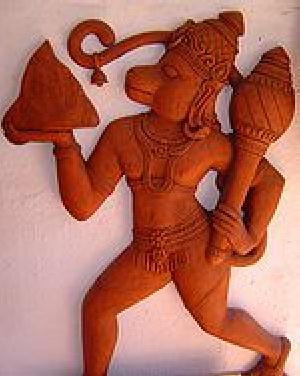 A gada is a mace, made of wood or metal, with a spherical head with a knob or spike on top. It is used by Hanuman, Vishnu, and Balarama. Fighters may use one, or a pair of maces - one in each hand.
A gada is a mace, made of wood or metal, with a spherical head with a knob or spike on top. It is used by Hanuman, Vishnu, and Balarama. Fighters may use one, or a pair of maces - one in each hand.
Gandiva is a bow made by Brahma. It was held by various deities for hundreds of years. No ordinary human can wield the bow. It has 100 bowstrings and makes the sound of thunder when it is used.
The garudastra is an astra possessed by Garuda, the eagle upon whom Vishnu rides. It counteracts the nagaastra, and was used by Rama.
The halayudha is a plough which is wielded by Balarama as a weapon.
A hans or hansa is a swan, symbolizing spiritual perfection and the ability to discriminate between good from evil.
The indraastra is an astra possessed by Indra, which can bring a shower of arrows from the sky.
Kalandanda is the Staff of Death - it was given by Brahma to Yama the god of the underworld. It is a club which can kill anyone, no matter what protective spells are used.
A kartri is a hooked sword. Kali wields a kartri
Kaumodaki is the mace possessed by Vishnu. It is used by Vishnu and some of his avatars. It is unconquerable, and can destroy a whole army.
The Kaustubha is a jewel possessed by Vishnu.
A khanda is a double-edged sword with a wide flat blade with a blunt tip. There may be a spike at the end of the hilt, as an extra grip when using two-handed, or as a stabbing weapon. The khanda can be used one-handed or two-handed. NOTE - the Sikhs use a khanda which is curved.
A khatvanga is a long club, made of bone, wood, or metal, studded with metal. It may be used as a weapon, or as a symbol of authority. Shiva carries a khatvenga.
The maheshwarastra is an astra possessed by Shiva. It contains the power of Shiva's third eye, and shoots a fiery beam which can turn the whole universe into ashes.
A mala is a circlet of prayer beads, used for meditation and prayer.
The manavastra is an astra owned by Manu, the father of the human race. It can overpower magical protections, and can carry its target far away. It can also impart human traits to an evil being. It was used by Rama against demons.
The mohini astra is possessed by Mohini, an avatar of Vishnu, and is used to dispel any sorcery.
A naga is a snake - particularly the King Cobra. The King of the Nagas is Shesha, to whom Brahma gave the task of carrying the earth. Shesha and the eagle Garuda are half-brothers or cousins, but there is enmity between them. Nagas are nature-spirits who bring rain - but they may also bring floods or cause drought. Vishnu is protected by a naga, and may recline on one. Ganesha wears a naga round his throat or his waist, or sits on one, or holds one in his hand. Shiva is garlanded by nagas.
The nagaastra is an astra possessed by the Nagas (serpents). It takes the form of a snake, and strikes with deadly accuracy. One of sone of the demon Ravana used it against Rama.
The nagapasha is a weapon used by the Nagas. It binds its target in coils of living venomous snakes. It was used against Rama and Lakshmana.
Nandaka is the name of the sword used by Vishnu. Its blade is indestructible. It represents knowledge, and is used to destroy ignorance. It was used by Krishna to kill demons.
The narayanastra is possessed by Vishnu in his avatar of Narayana. It produces showers of arrows or discs. It can only be used one in a life-time. If the user attempts a second use it will rebound on him. The only defense against the narayanastra is to submit instantly before the missiles strike - in that case the missiles will stop nd spare the target.
A padma is a lotus. A lotus plant grows in water - its roots are in the mud, and its flower rises on a long stalk to the surface. Hence it can symbolize the rise of the soul, or purity rising out of decay. Its opening petals represent the opening of spiritual awareness. Many of the deities may be depicted holding a lotus, or sitting on a lotus. One tradition says that Brahma came into being in a lotus which grew from the navel of Vishnu.
 A parashu is a battle-axe with a long handle. It may be used one-handed or two-handed, and it may have one blade, two blades, or one blade and a spike. It is one of Shiva's weapons. Shiva gave the axe to Parashurama, the sixth avatar of Vishnu, and taught him how to use it. Then Parashurama taught a guild of warriors. Parashurama gave the axe to Ganesha. It is also also used by Durga.
A parashu is a battle-axe with a long handle. It may be used one-handed or two-handed, and it may have one blade, two blades, or one blade and a spike. It is one of Shiva's weapons. Shiva gave the axe to Parashurama, the sixth avatar of Vishnu, and taught him how to use it. Then Parashurama taught a guild of warriors. Parashurama gave the axe to Ganesha. It is also also used by Durga.
The parvataastra causes a mountain to fall from the skies and crush an enemy.
The pasha is a celestial weapon used for hunting, and for binding a foe's arms and legs. Ganesha and Varuna may be depicted with a pasha.
The pashupatastra is an astra possessed by Shiva. It can destroy any target. It can only be stopped by Shiva.
Pinaka is a bow possessed by Shiva and given to Parashurama. Arrows from the bow could not be intercepted. It was passed down to the father of Sita.
The rudra astra is possessed by Shiva. It has the power to destroy its target, and it is thought that there is no counter-weapon.
The sabda-veda astra has the power of preventing an opponent from becoming invisible.
A shankha is a conch shell. It can be used as a trumpet in battle. Its sound is reminiscent of the "aum" syllable of Hinduism. It is used regularly in Hindu worship, either as a trumpet, or as a vessel for anointing a murti. It is used by Vishnu, Krishna, Surya, Durga, Lakshmi, and Indra.
Sharanga is the bow possessed by Vishnu. It was used by Rama and Krishna
The suryastra is an astra possessed by the Sun-god Surya. It produces a dazzling light to conquer all darkness. It dries up all seas and bodies of water.
The Syamantaka is a jewel with magical powers.
Teen Baan are three arrows possessed by Shiva. They are invincible. One arrow flies to mark all the enemies to be destroyed; it returns to the quiver. The second arrow is used to mark all that the shooter wishes to be saved; then it returns to the quiver. The third arrow is used to destroy all those marked by the first arrow.
 A trishula is a trident. Shiva has a trident called Trishul, made from sun-dust, and which cannot be stopped by anyone except Shiva. Durga, Kali, and several other deities also use a trident.
A trishula is a trident. Shiva has a trident called Trishul, made from sun-dust, and which cannot be stopped by anyone except Shiva. Durga, Kali, and several other deities also use a trident.
The twasthtar astra is possessed by Twashtri, the celestial builder. It causes a group of enemies to mistake each other for foes and fight against each other.
The Vaidurya is the most precious of all jewels. It is worn by Lakshmi.
The vaishnavastra is an astra possessed by Vishnu. It is an invincible weapon which will utterly destroy a target.
 A vajra is a thunderbolt. It is also the name for a weapon or ritual object which was used as a representation of a thunderbolt. Indra uses a vajra to kill the wicked and ignorant. The vajra is also used by Murugan (Skanda)
A vajra is a thunderbolt. It is also the name for a weapon or ritual object which was used as a representation of a thunderbolt. Indra uses a vajra to kill the wicked and ignorant. The vajra is also used by Murugan (Skanda)
Varunapasha is the noose possessed by Varuna, from which no-one can escape.
The varunastra is a weapon possessed by Varuna. It produces torrents of water in opposition to the agneyastra. If it is used incorrectly it will destroy the person attempting to use it.
Vasavi Shakti is a celestial dart possessed by Indra.
The vayvayastra is an astra possessed by Vayu, the Wind-god. It is capable of lifting a whole army off the ground.
 A vel is a lance, javelin, or spear. It is often marked with the three white stripes denoting a devotee of Shiva. Parvati gave a vel to her son Murugan.
A vel is a lance, javelin, or spear. It is often marked with the three white stripes denoting a devotee of Shiva. Parvati gave a vel to her son Murugan.
Vijaya is the celestial bow which gives victory to its possessor - as long as he holds it in his hand. It was made especially for Shiva, who gave it for safe-keeping to Indra. Indra used it on several occasions. Then Shiva told Indra to give it to Parasurama to fight the evil committed in the world by the kshatrya caste. Parasurama used it effectively to restore order in the world. However, Parasurama had a student, Karna, to whom he gave the bow and some other celestial weapons. Karna used the bow only once, against Arjuna, and overpowered him but did not kill him. Krishna was a friend of Arjuna and warned him against Karna, and when Karna was victorious Krishna advised Arjuna to kill him by treachery. Karna's chariot wheel became stuck in the mud, so Karna dismounted from his chariot to lift it out of the mud, leaving the bow Vijaya behind. It was against all the rules of chivalry to kill an unarmed warrior, but that was the advice given by Krishna.
Copyright © 1999 Shirley J. Rollinson, all Rights Reserved